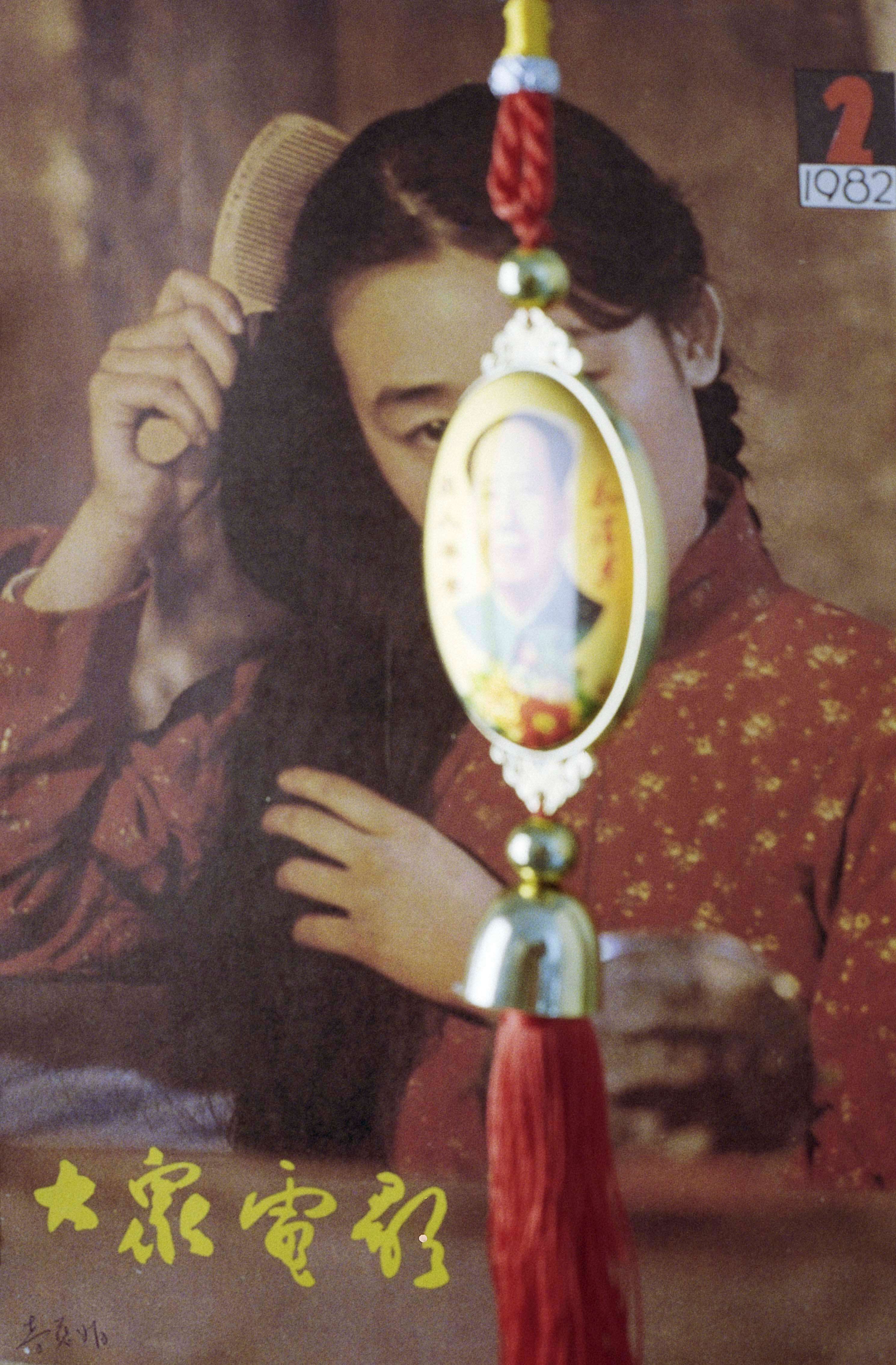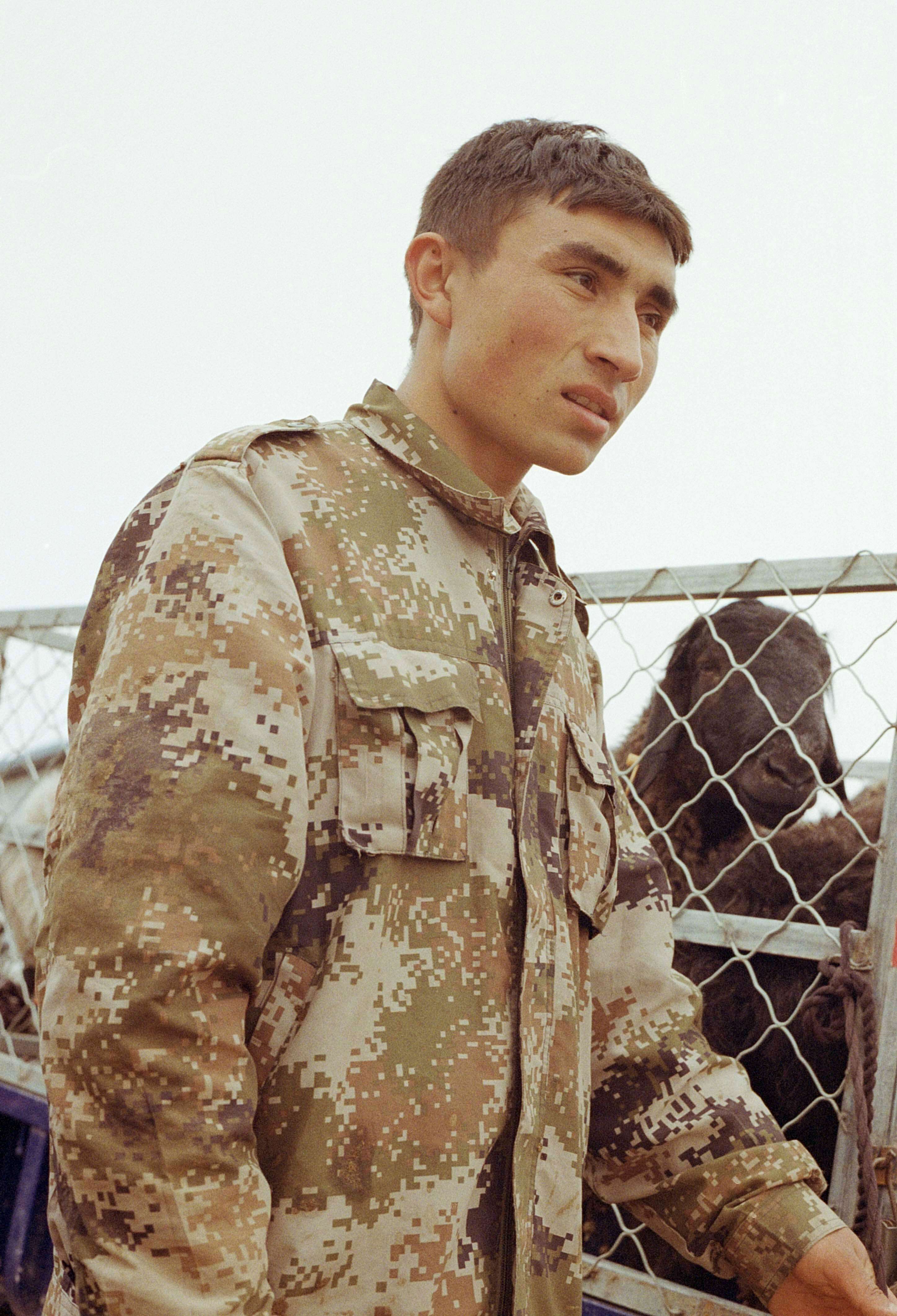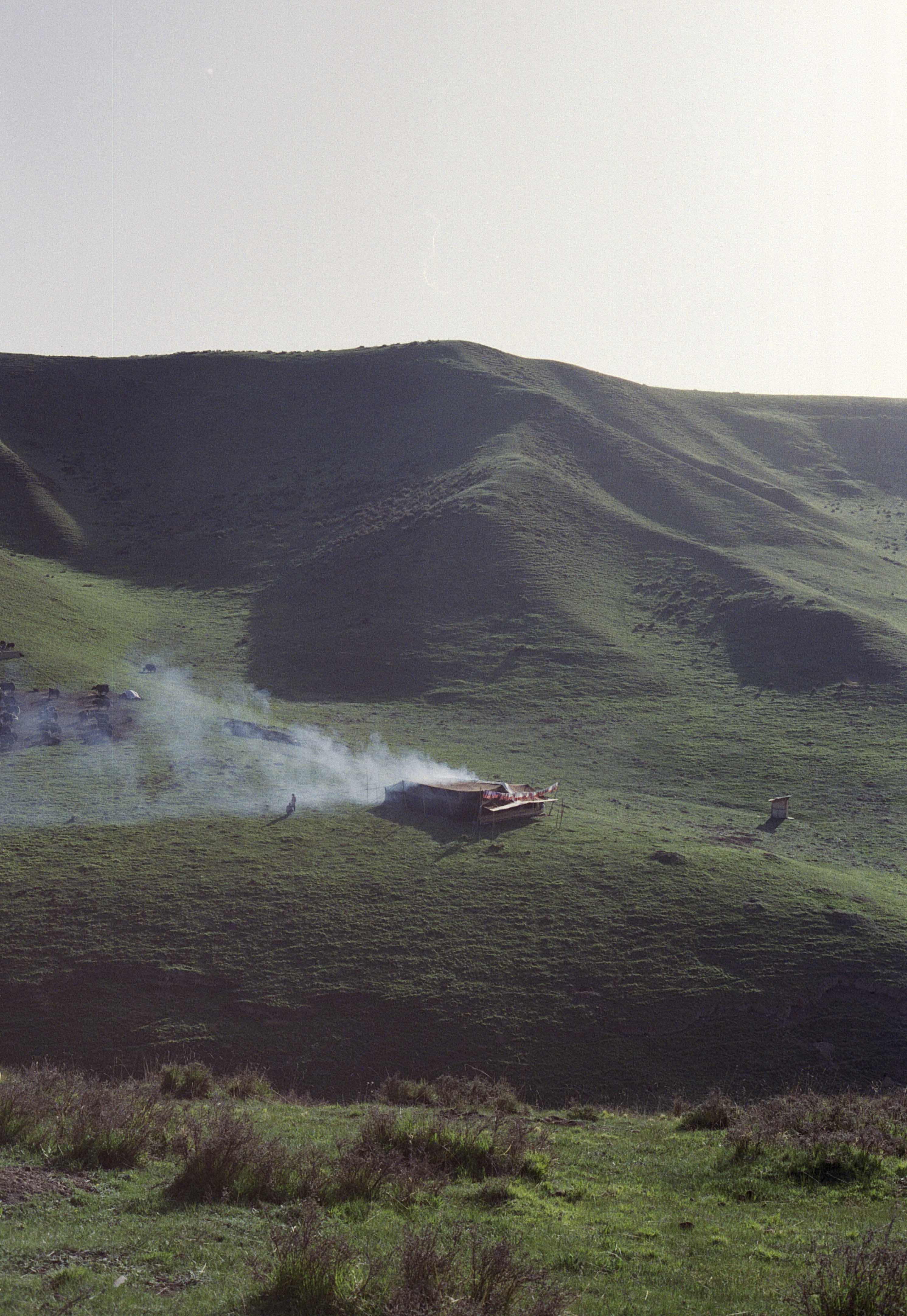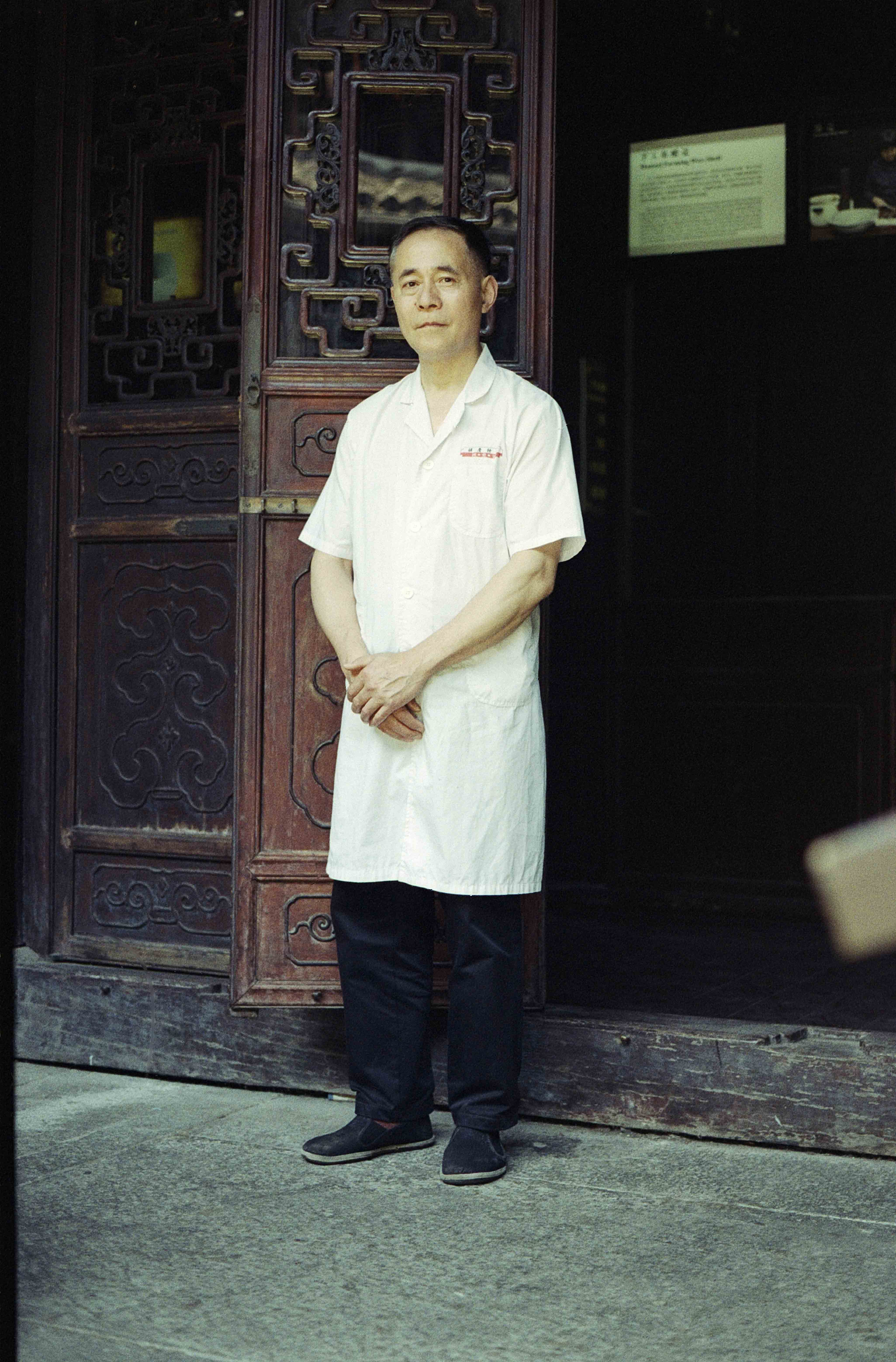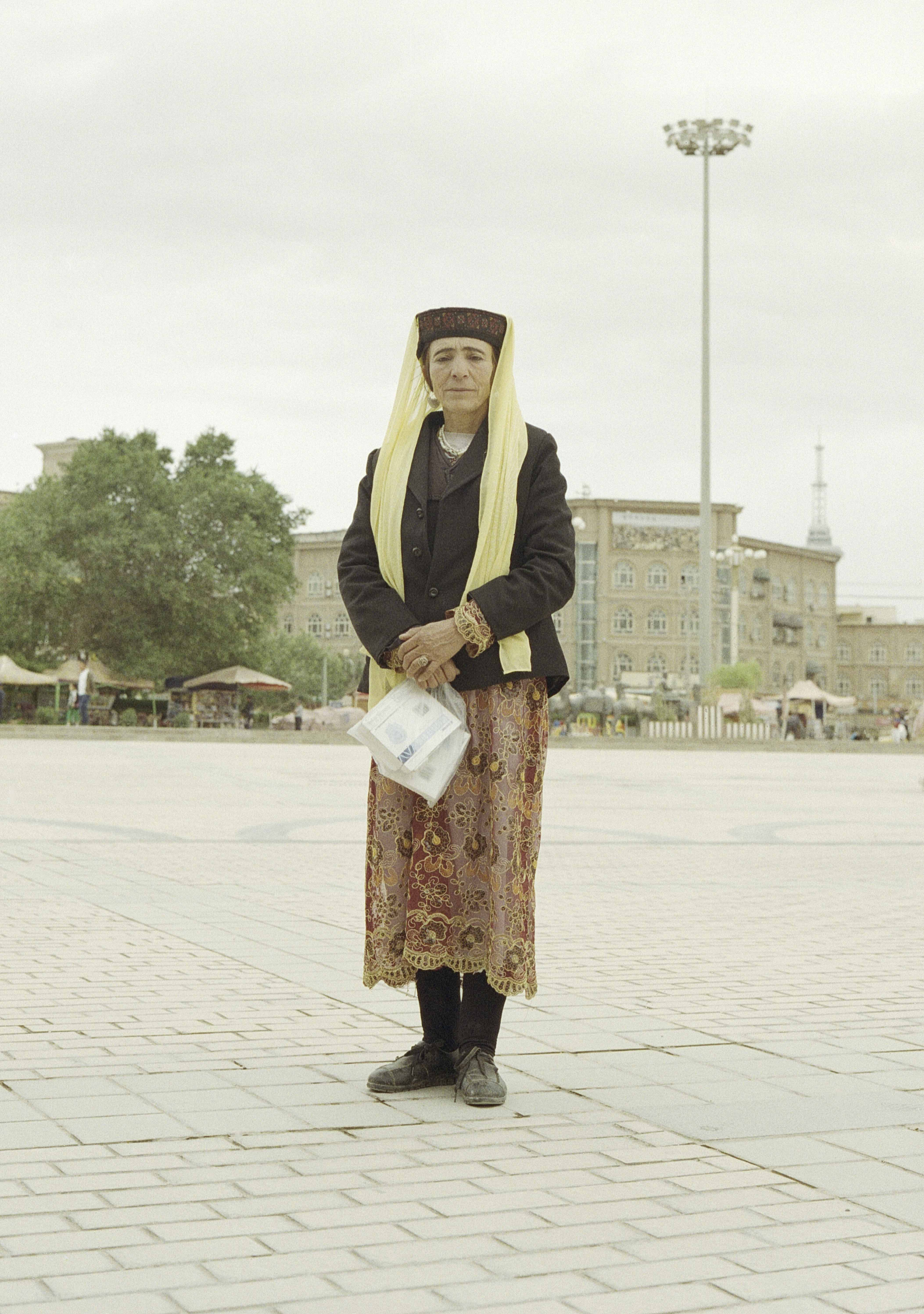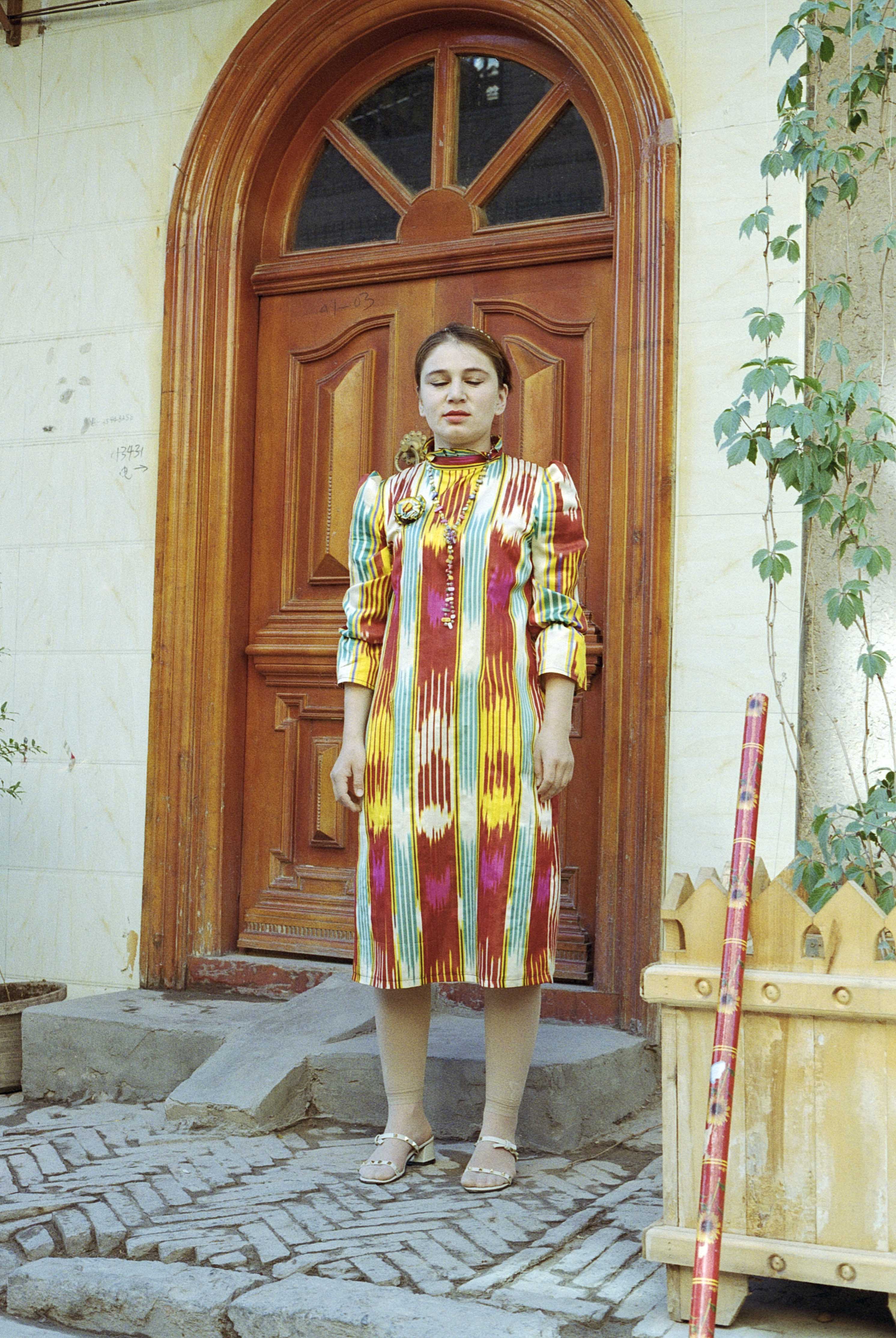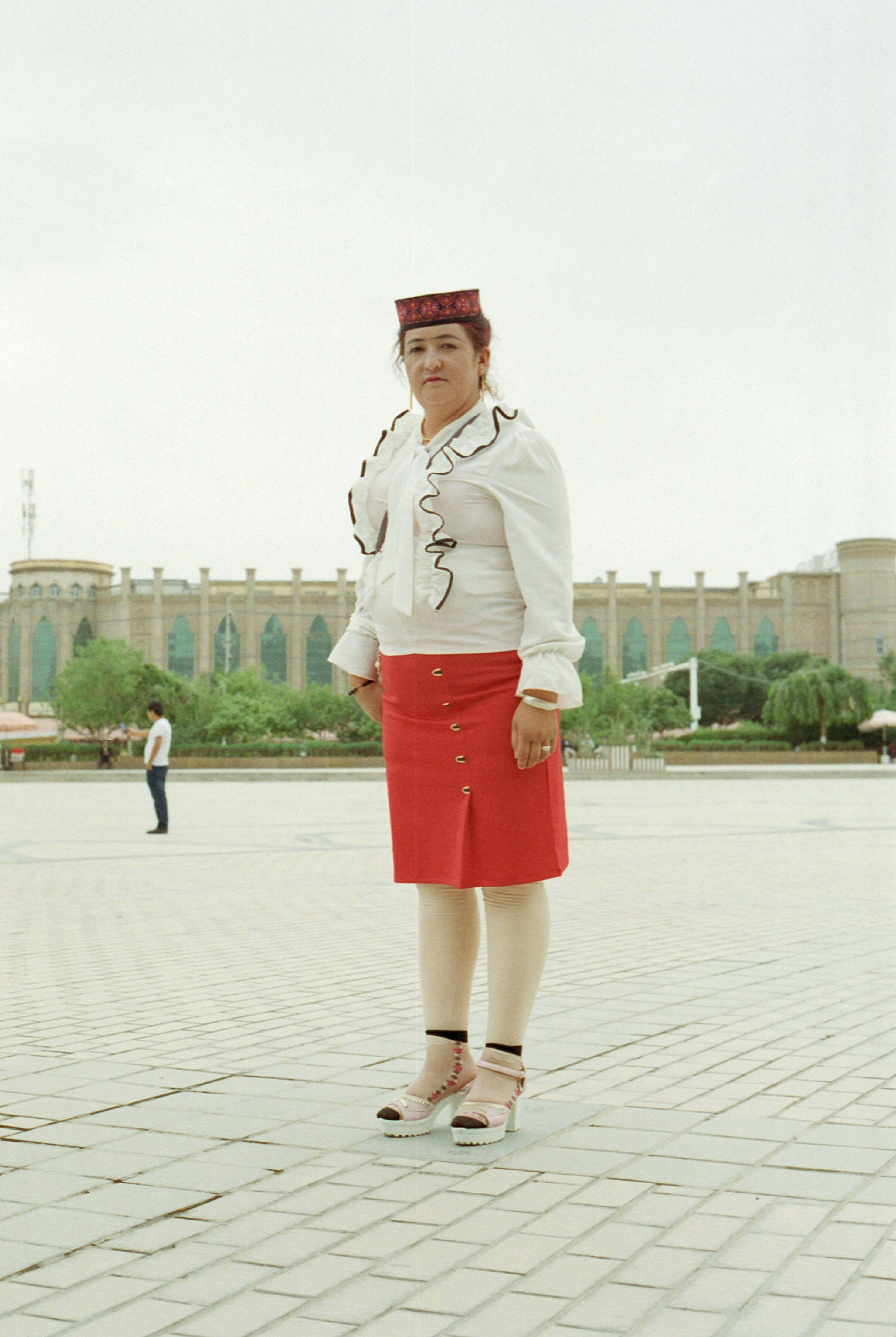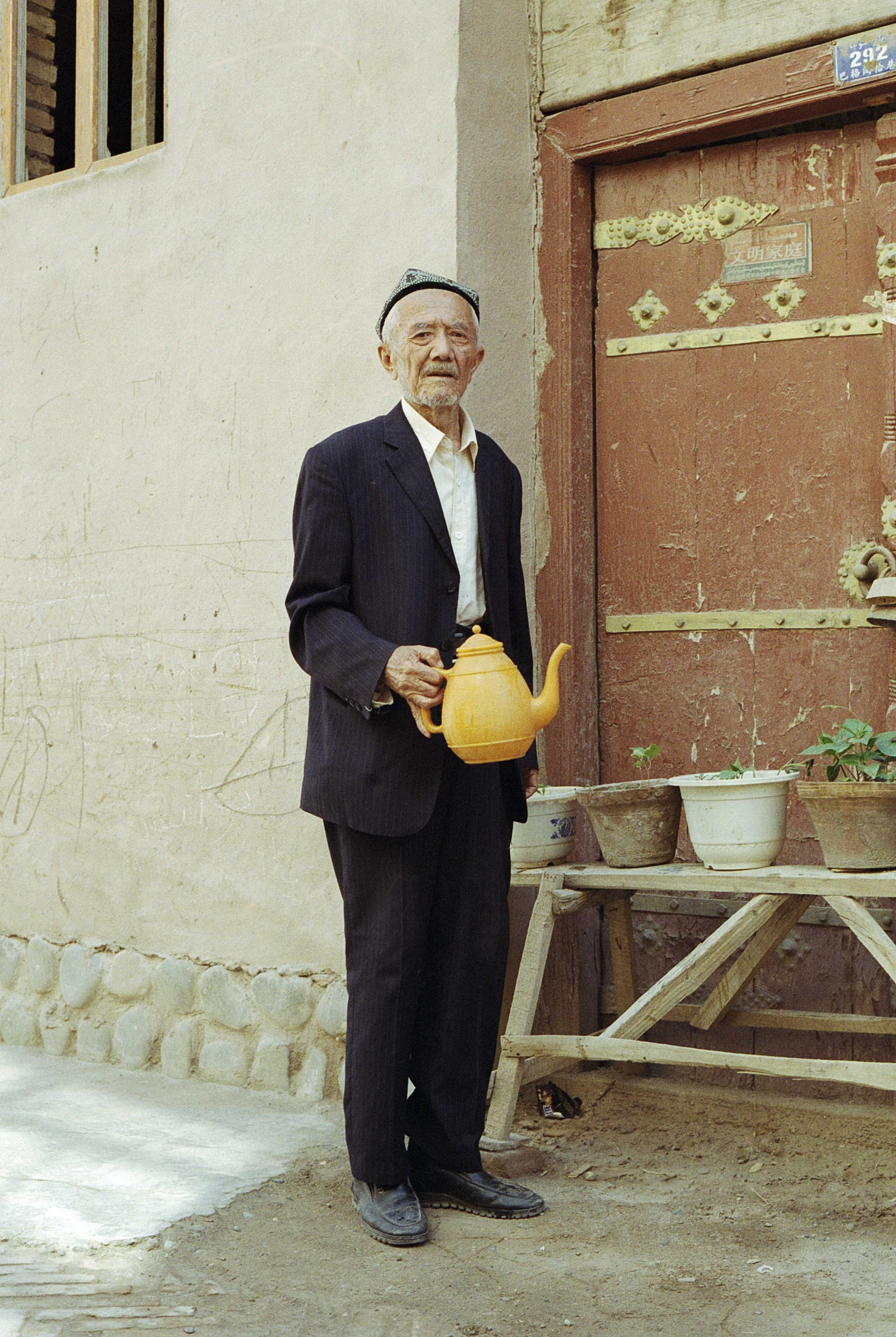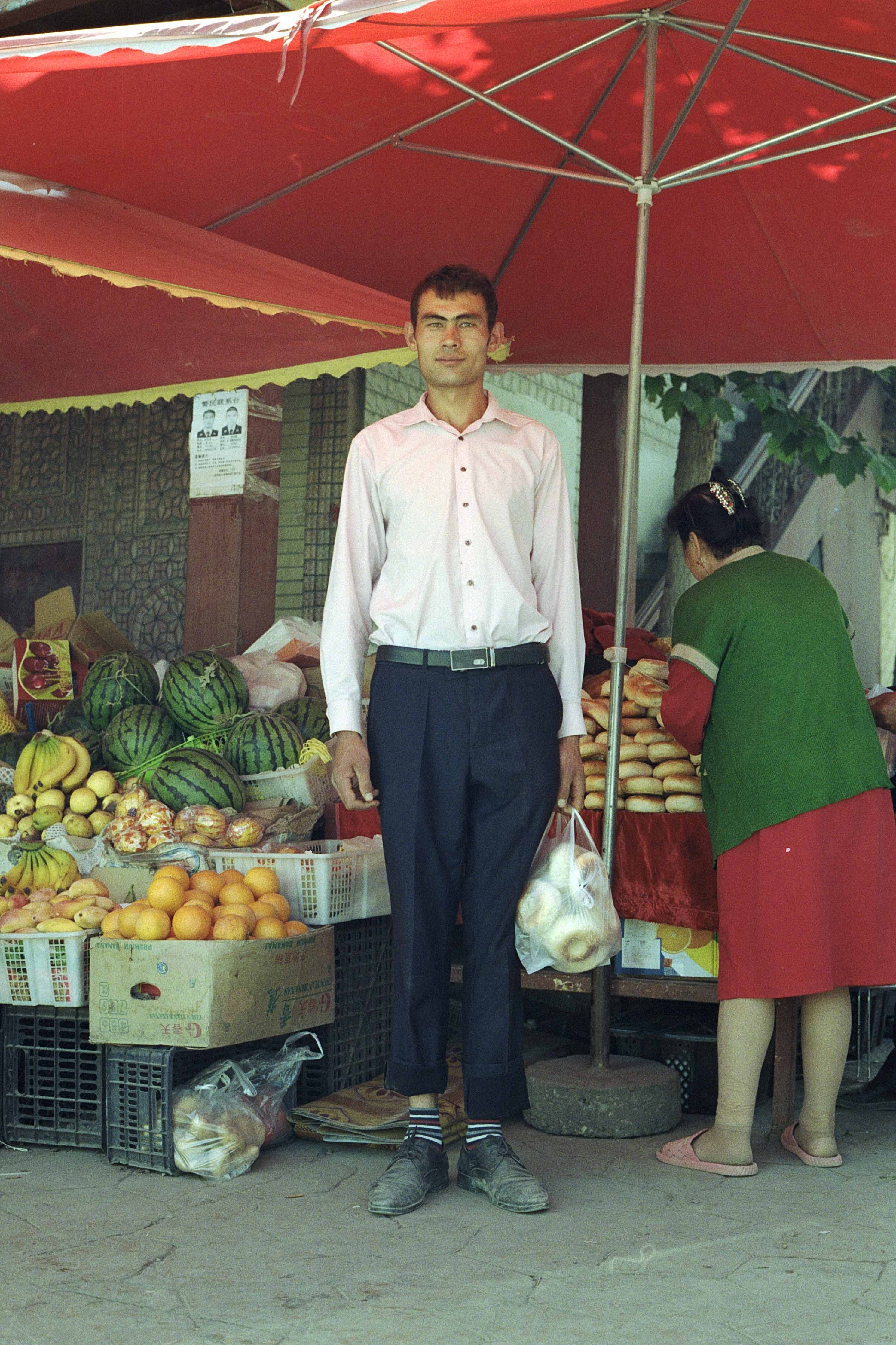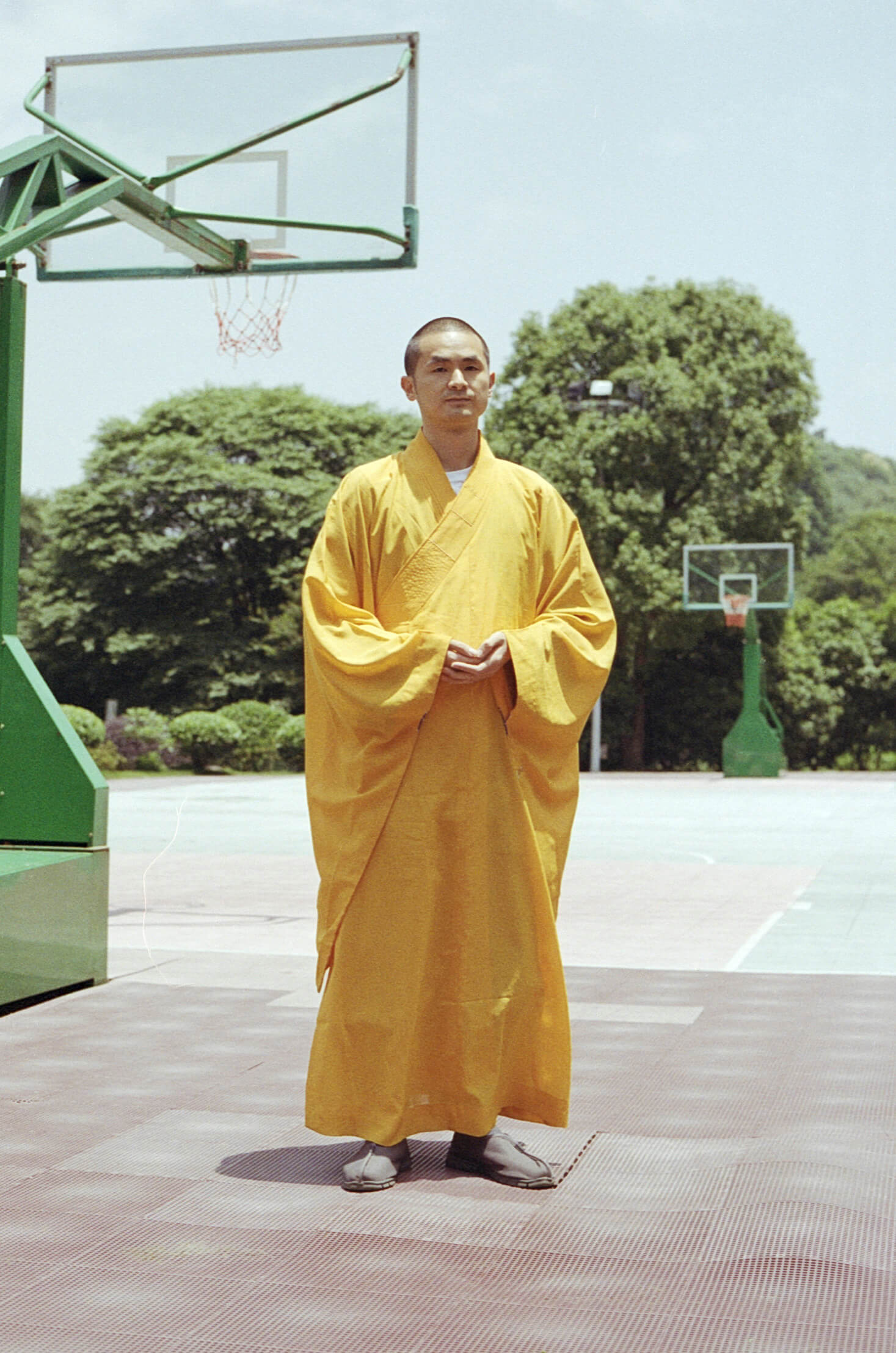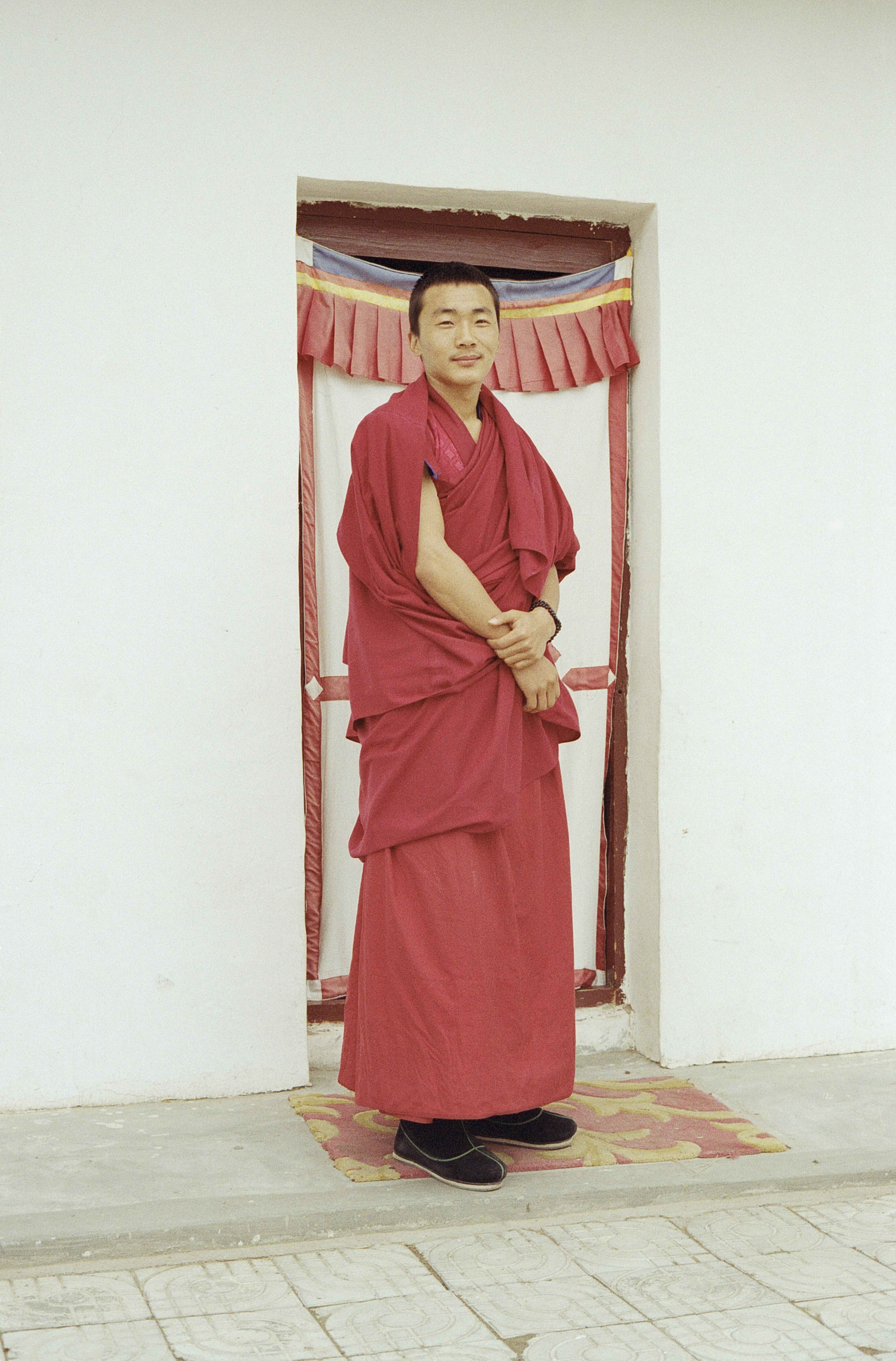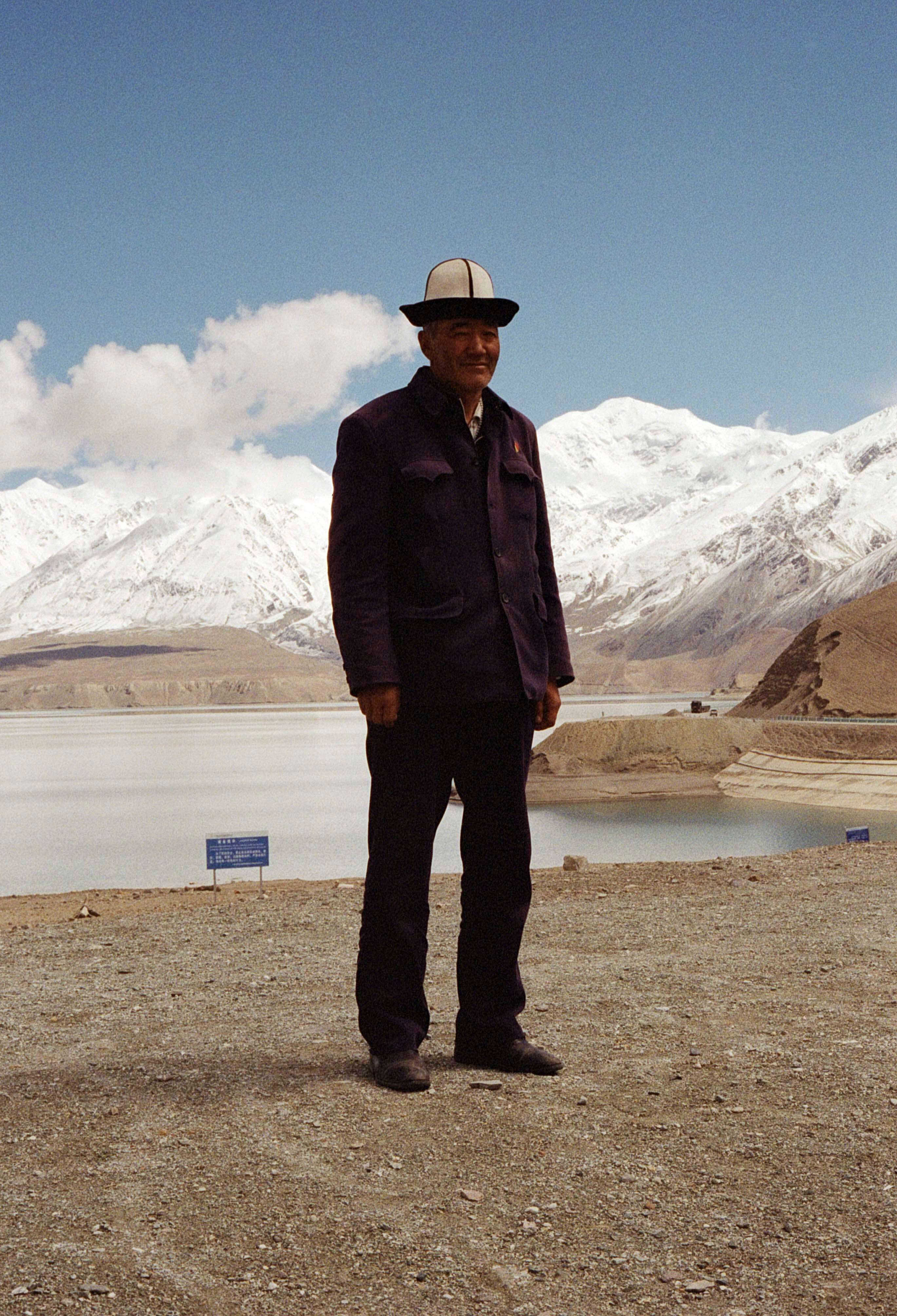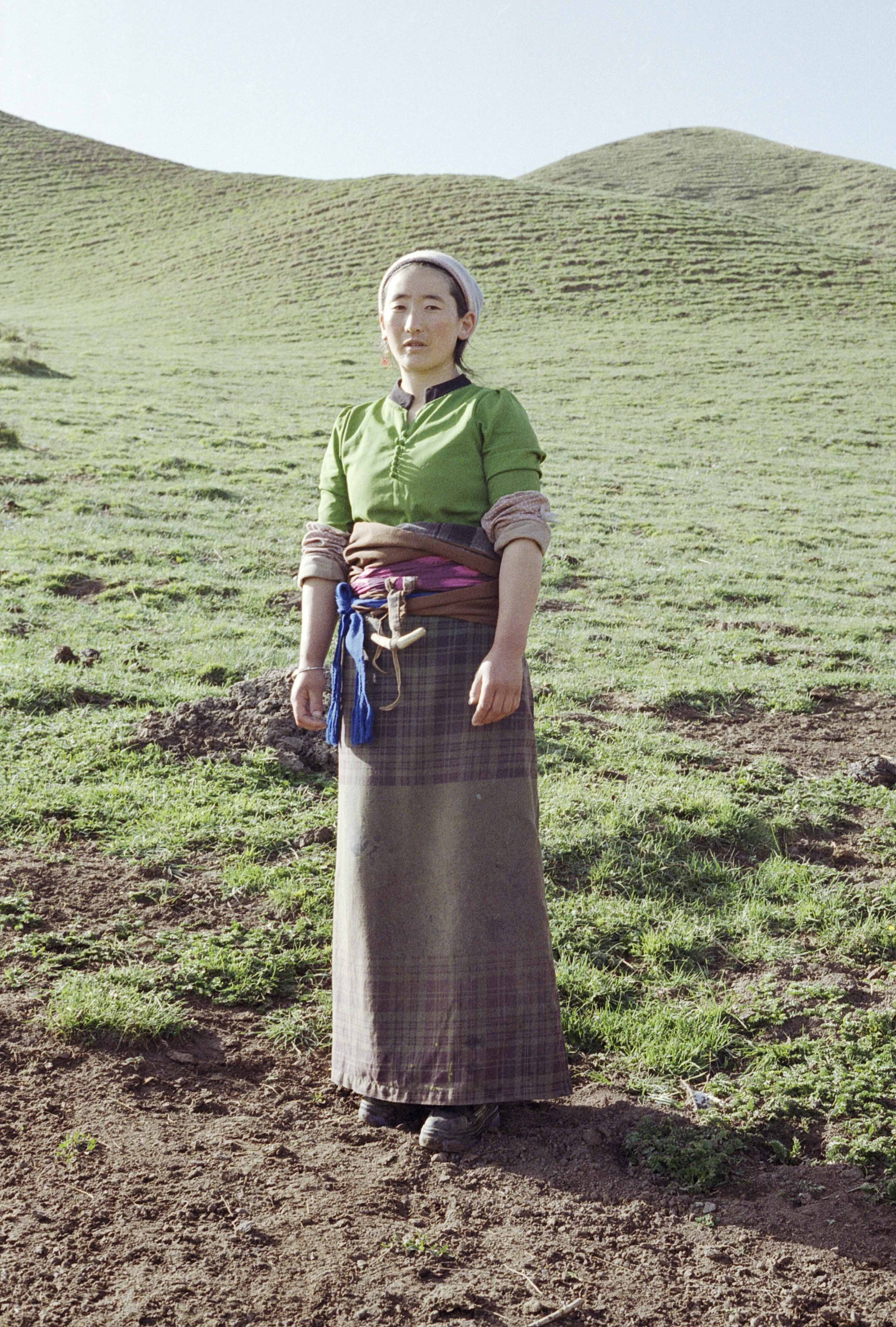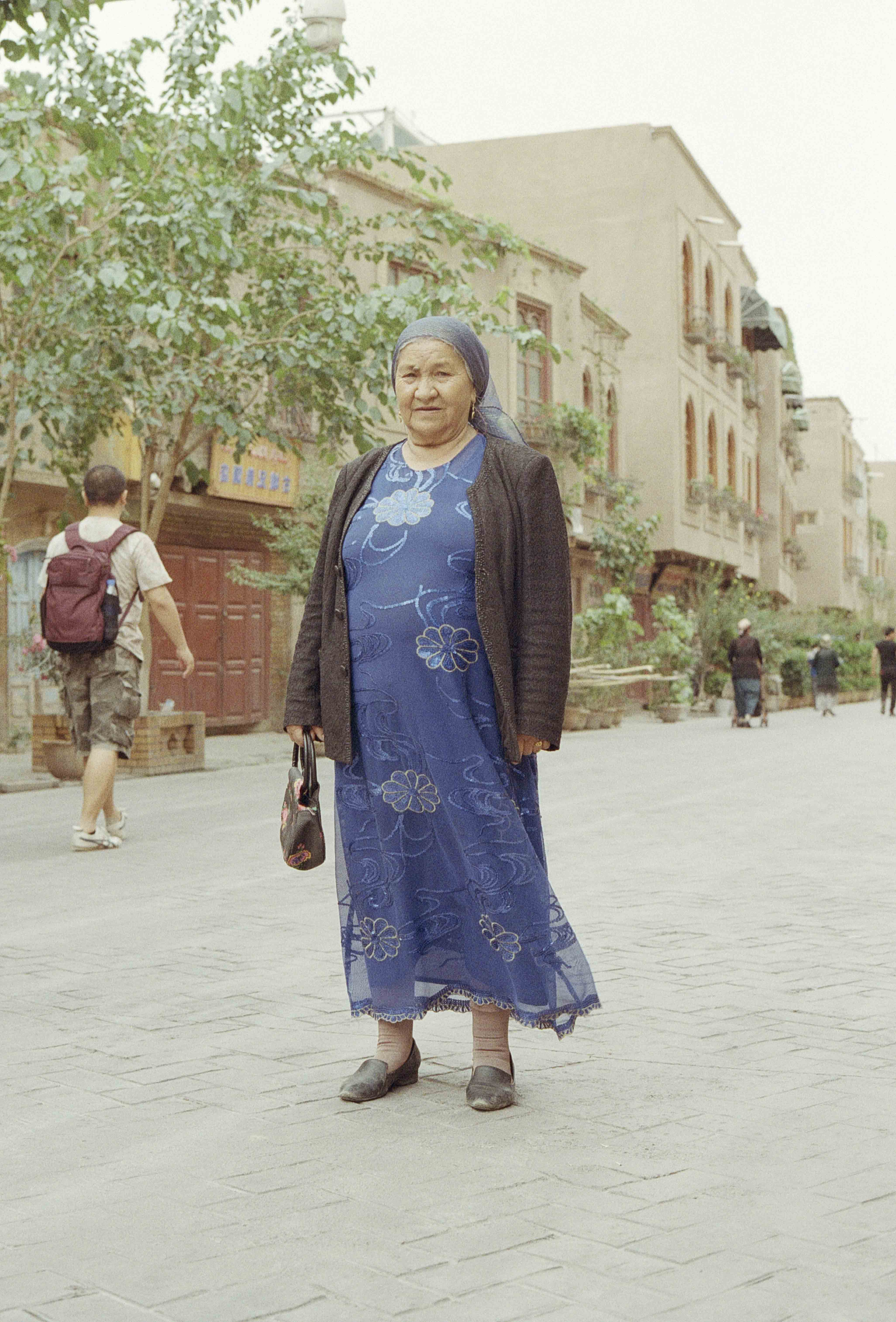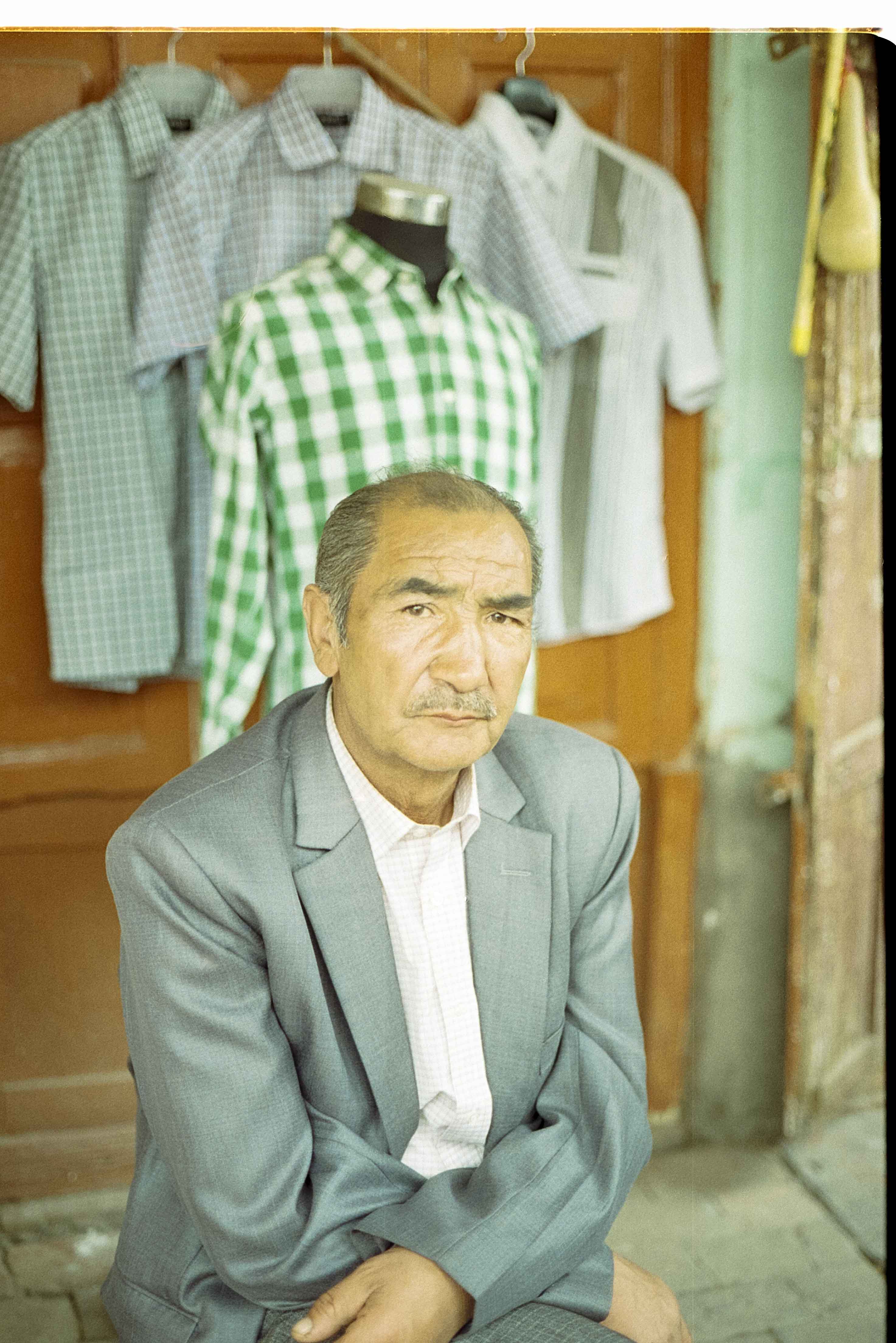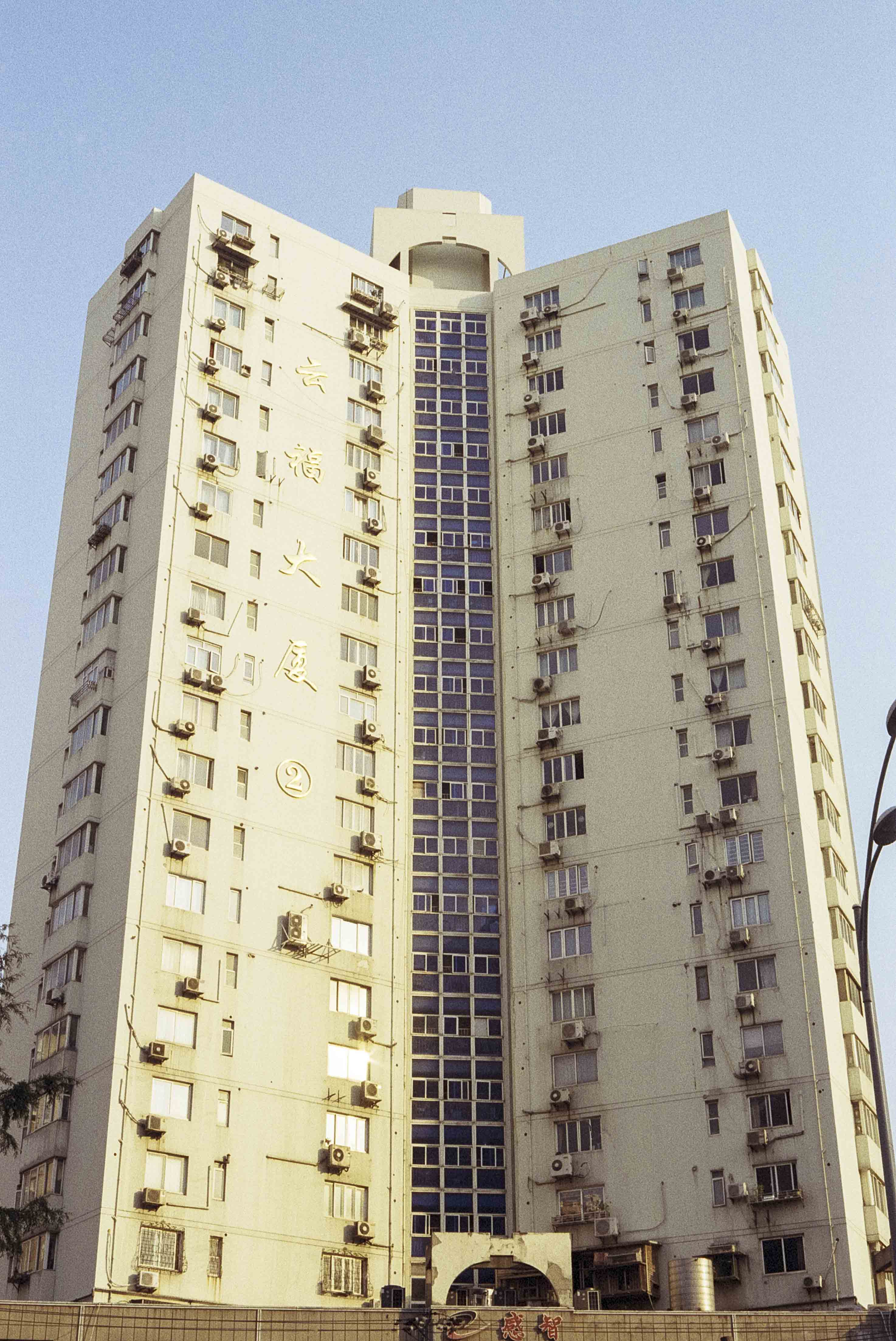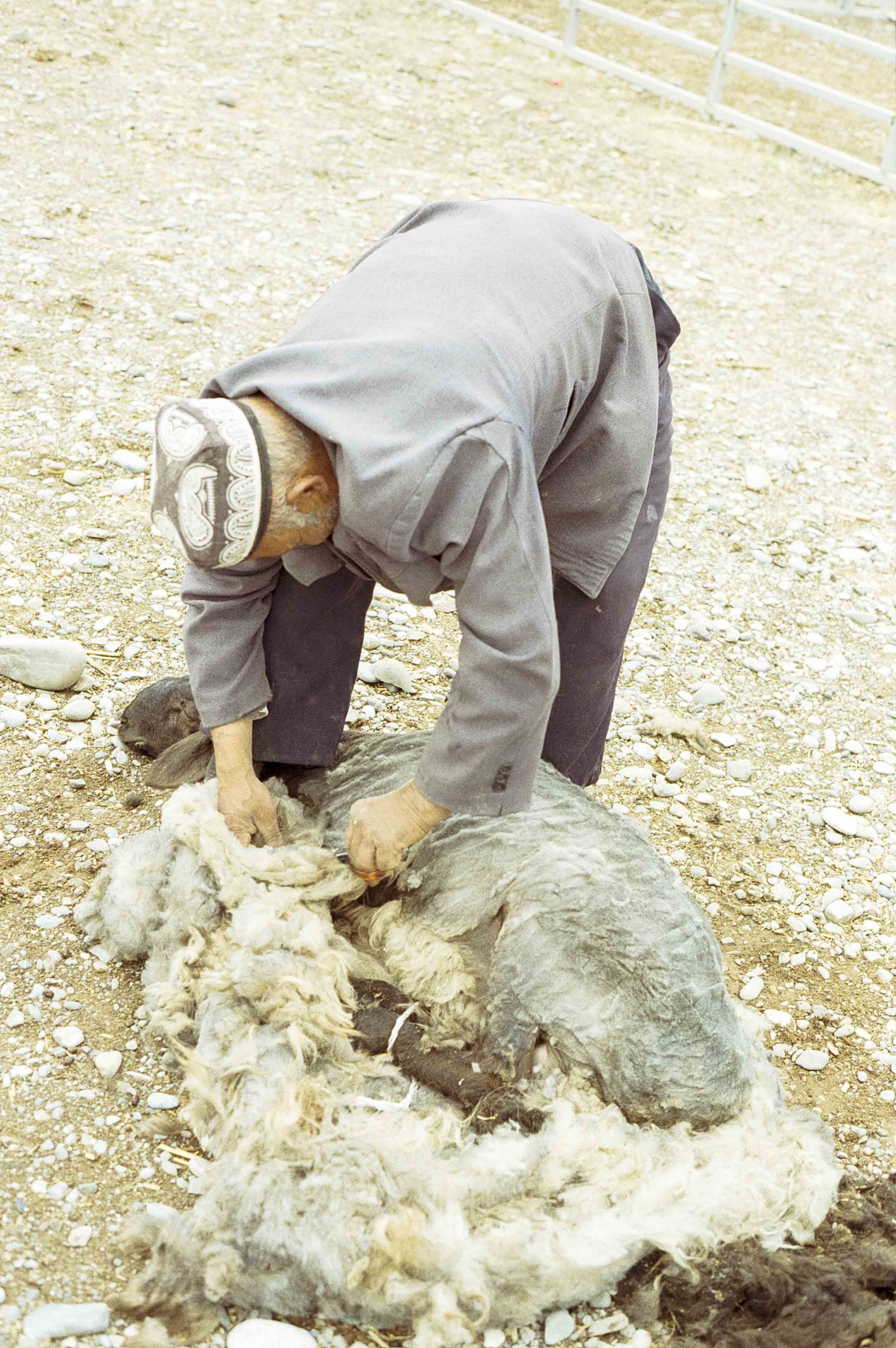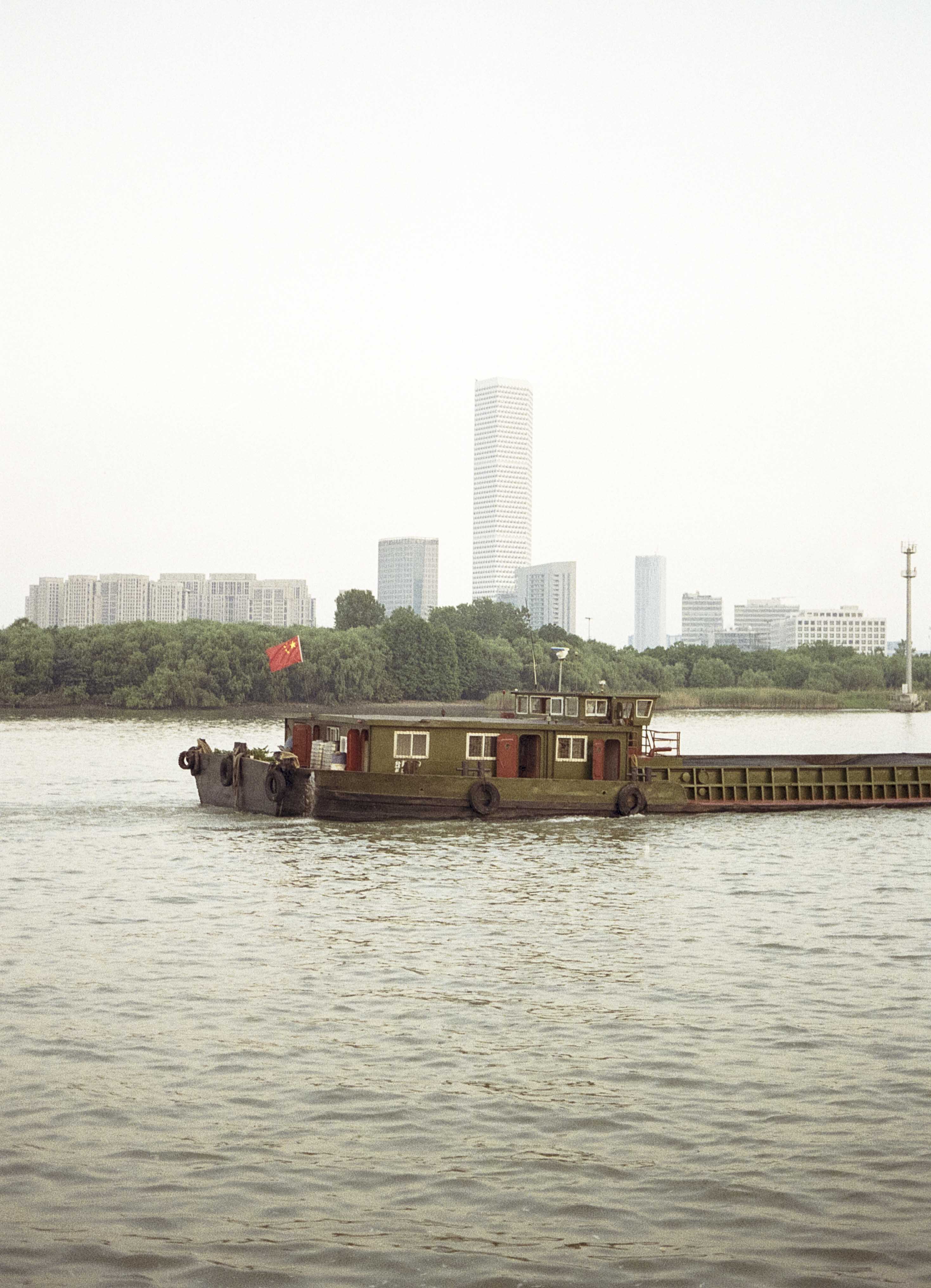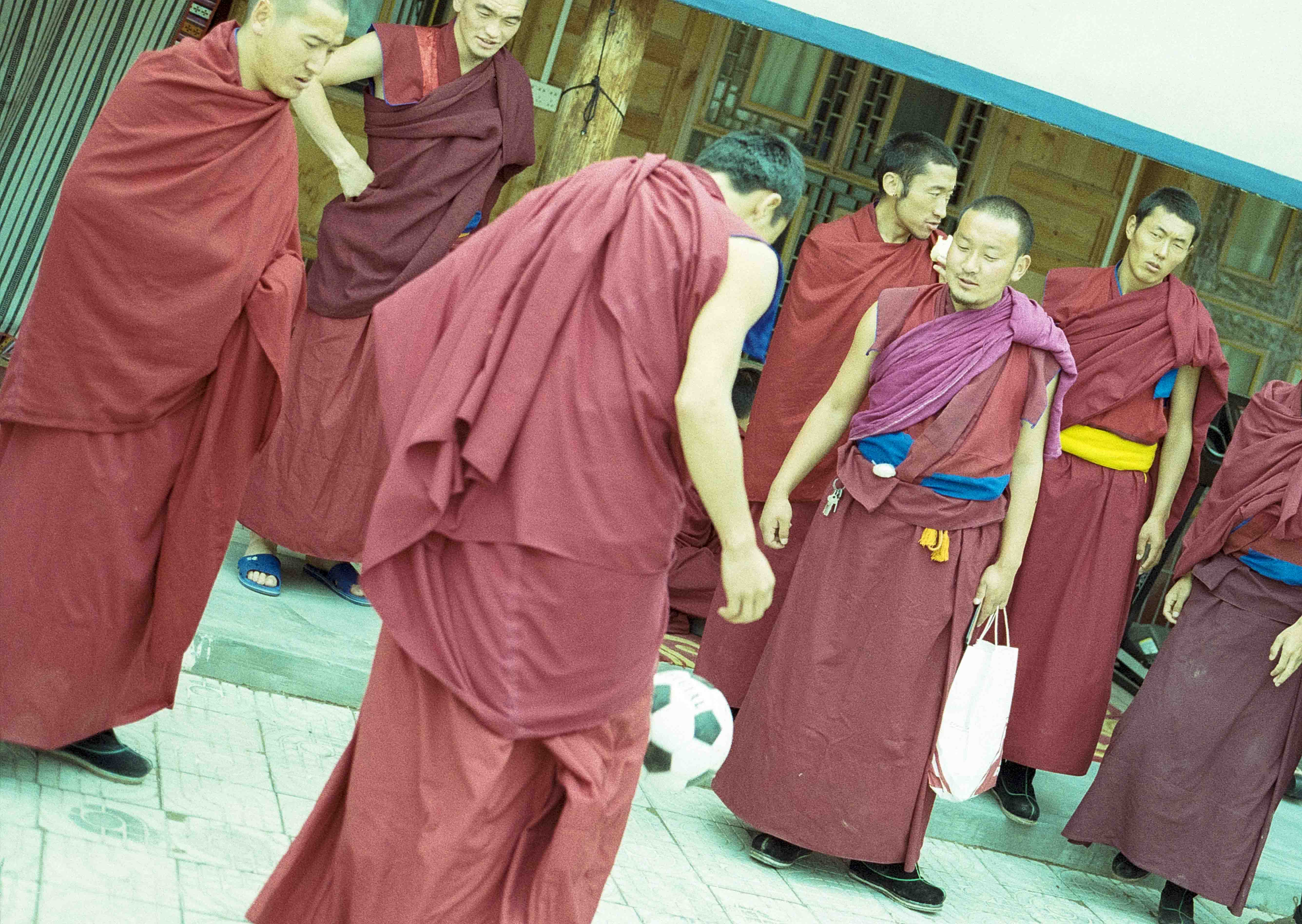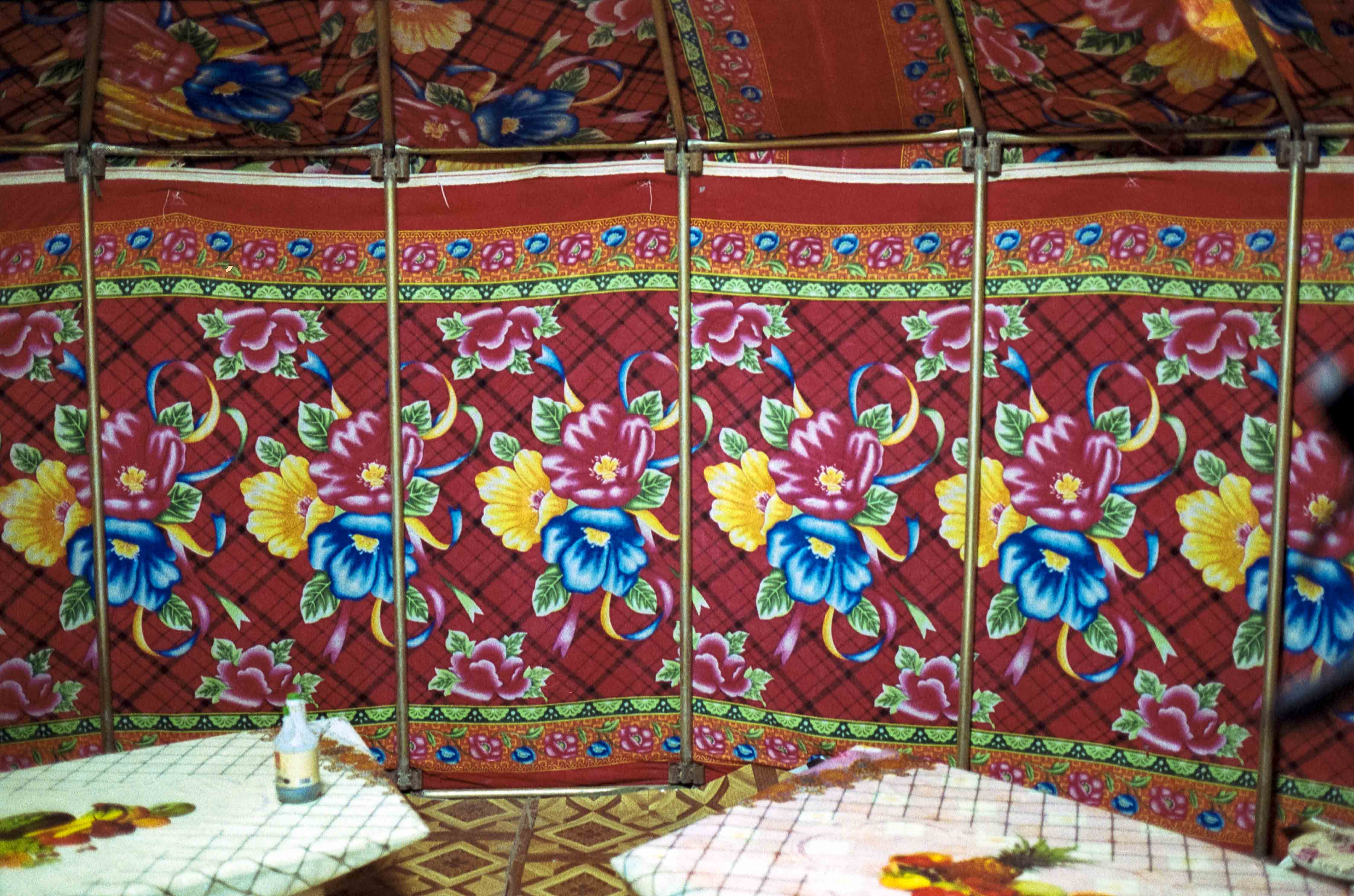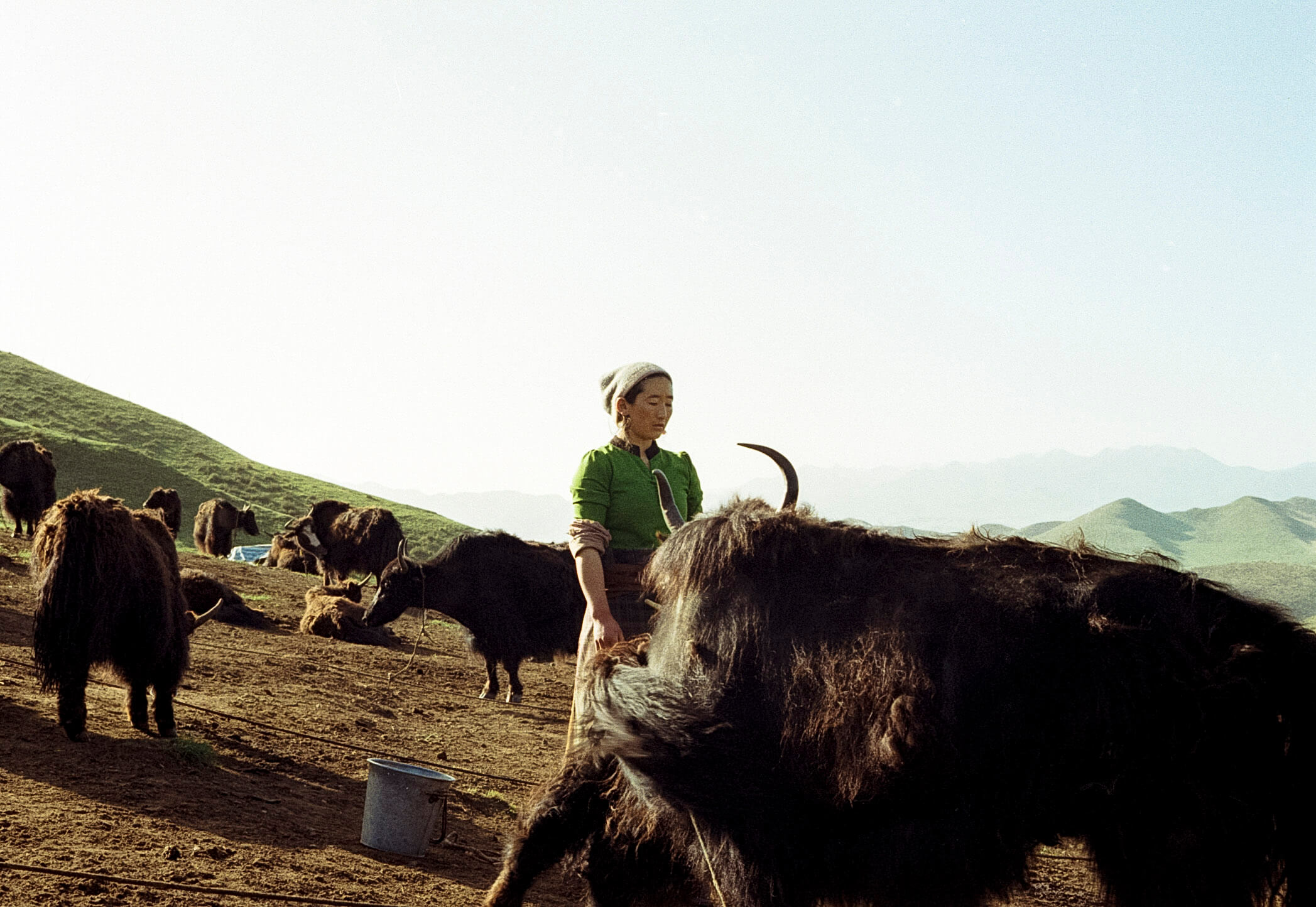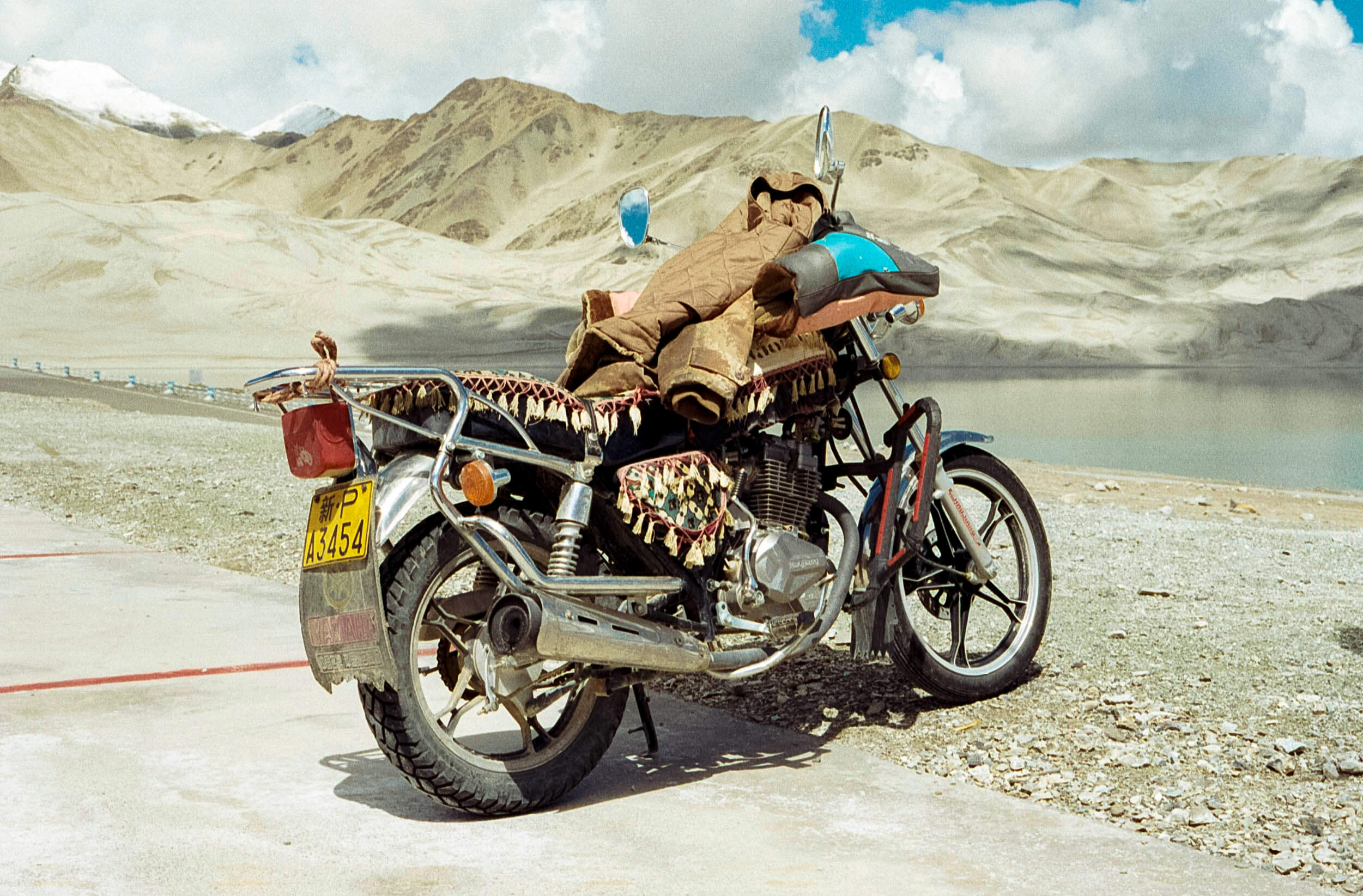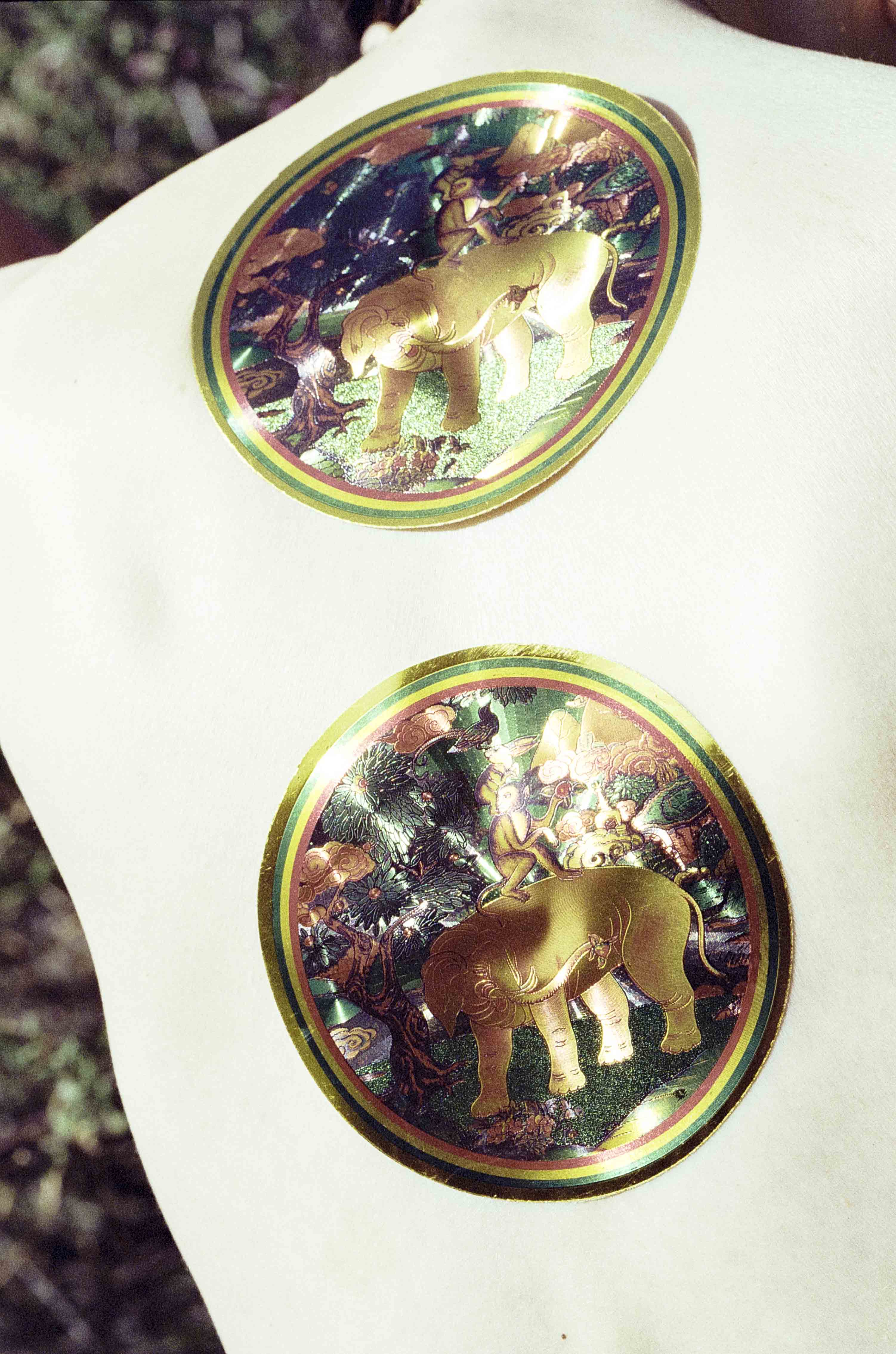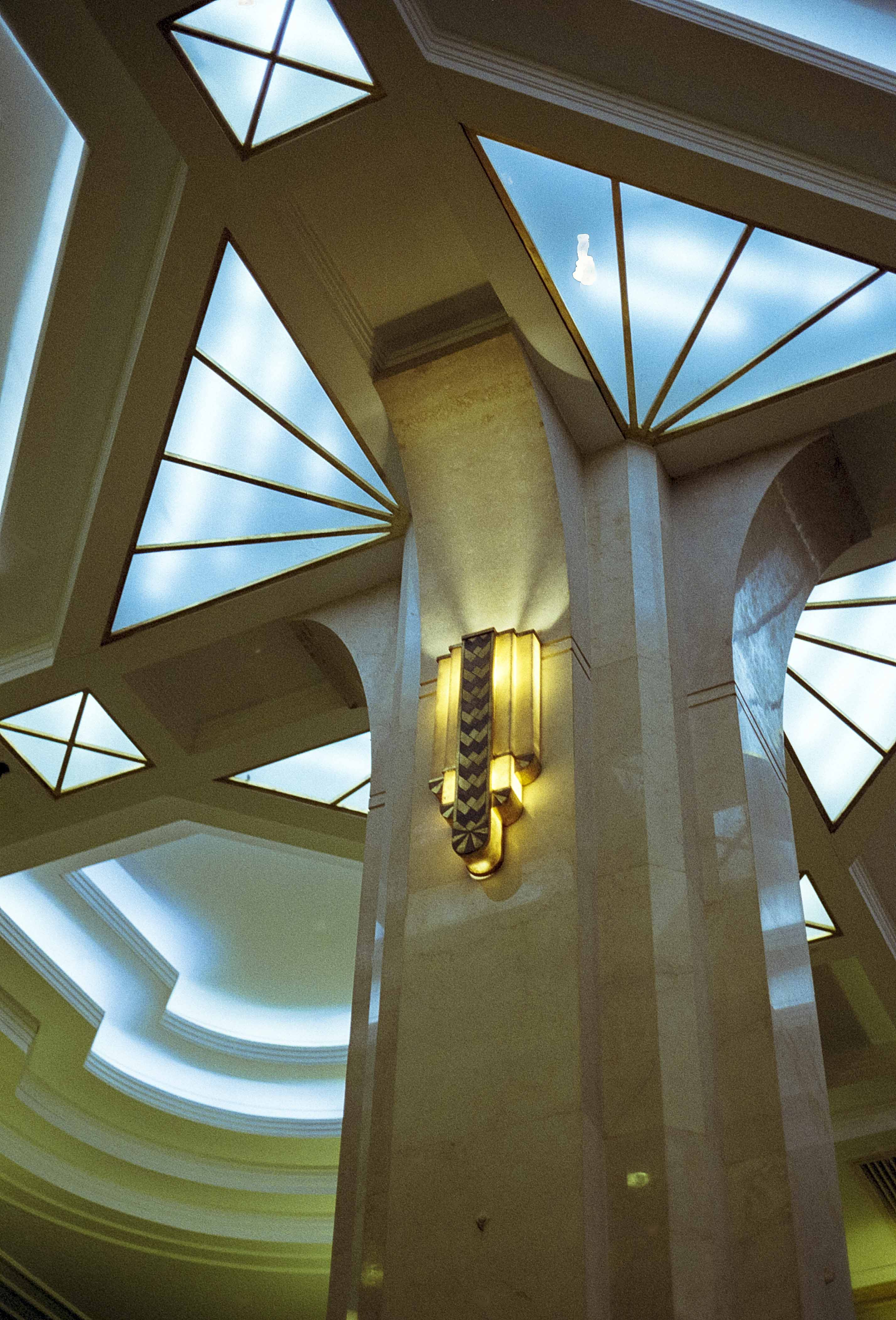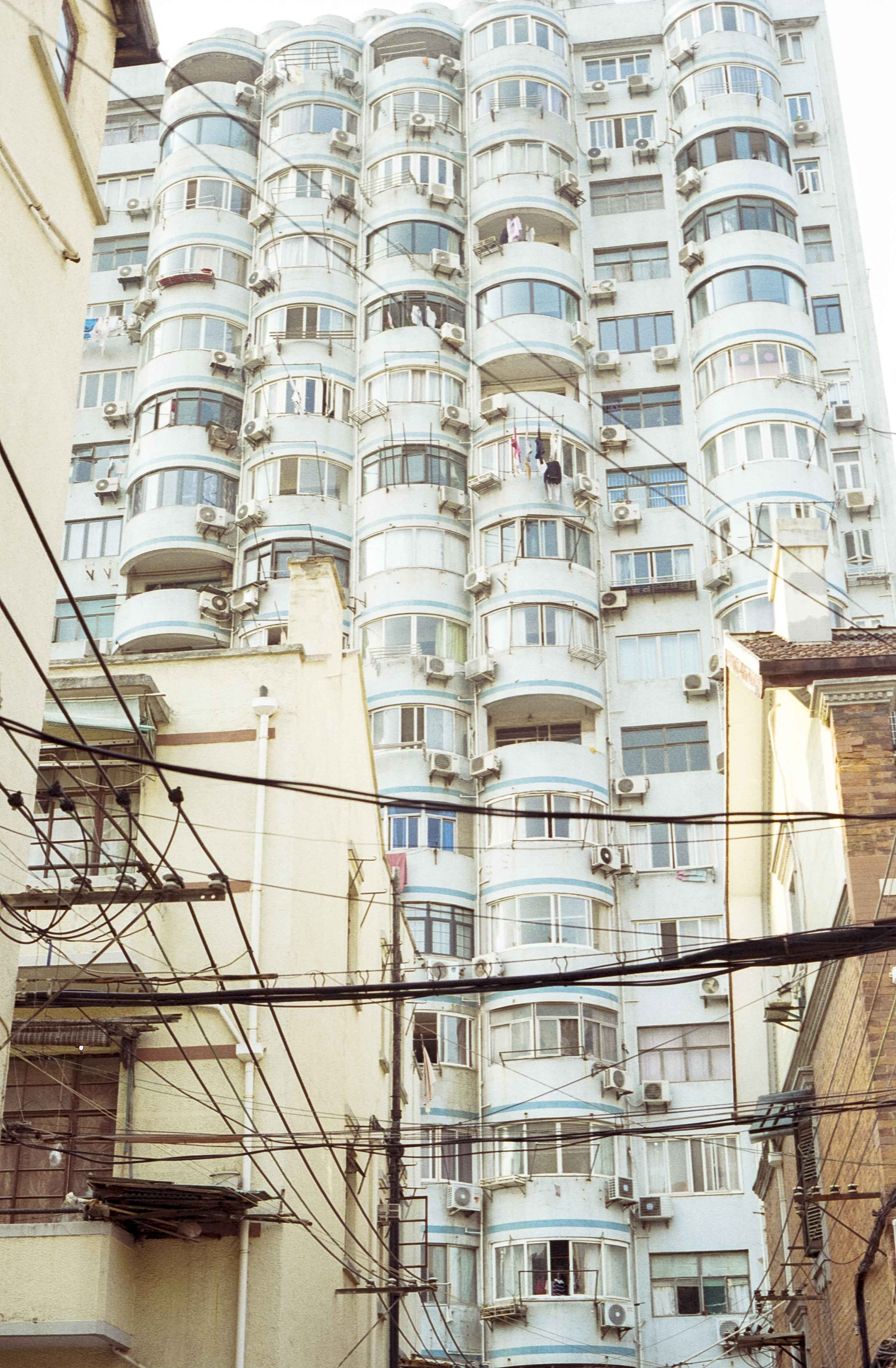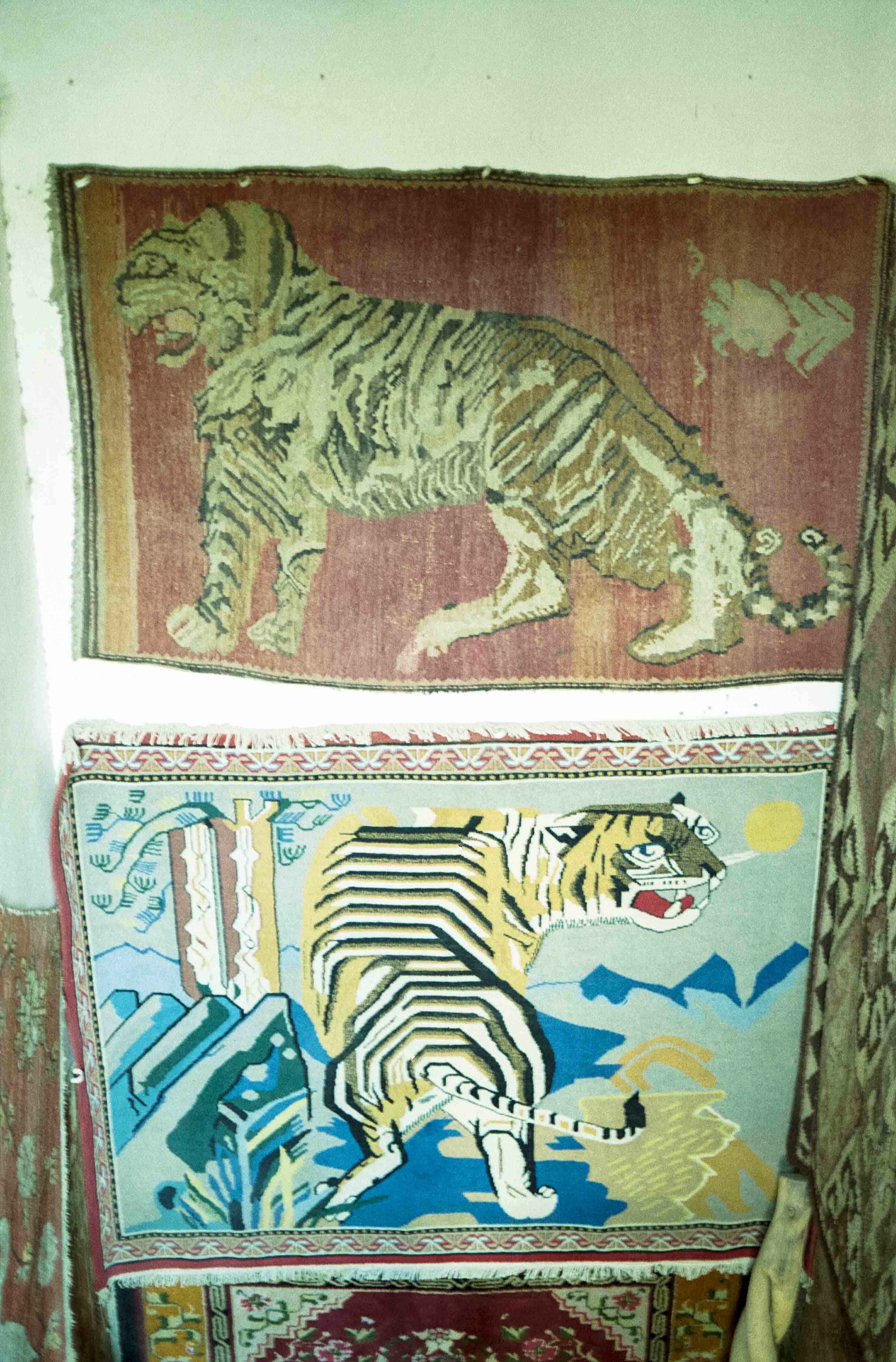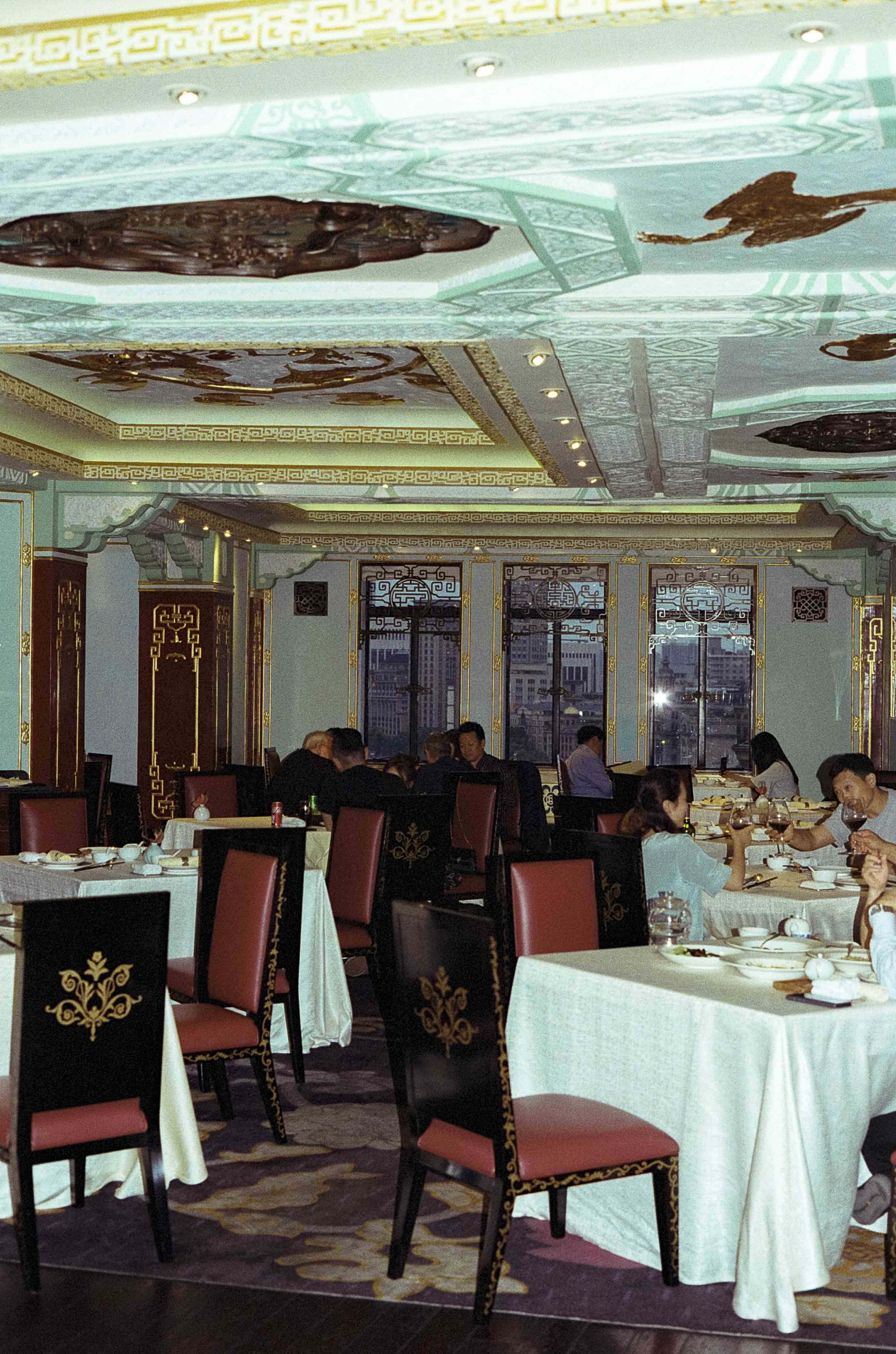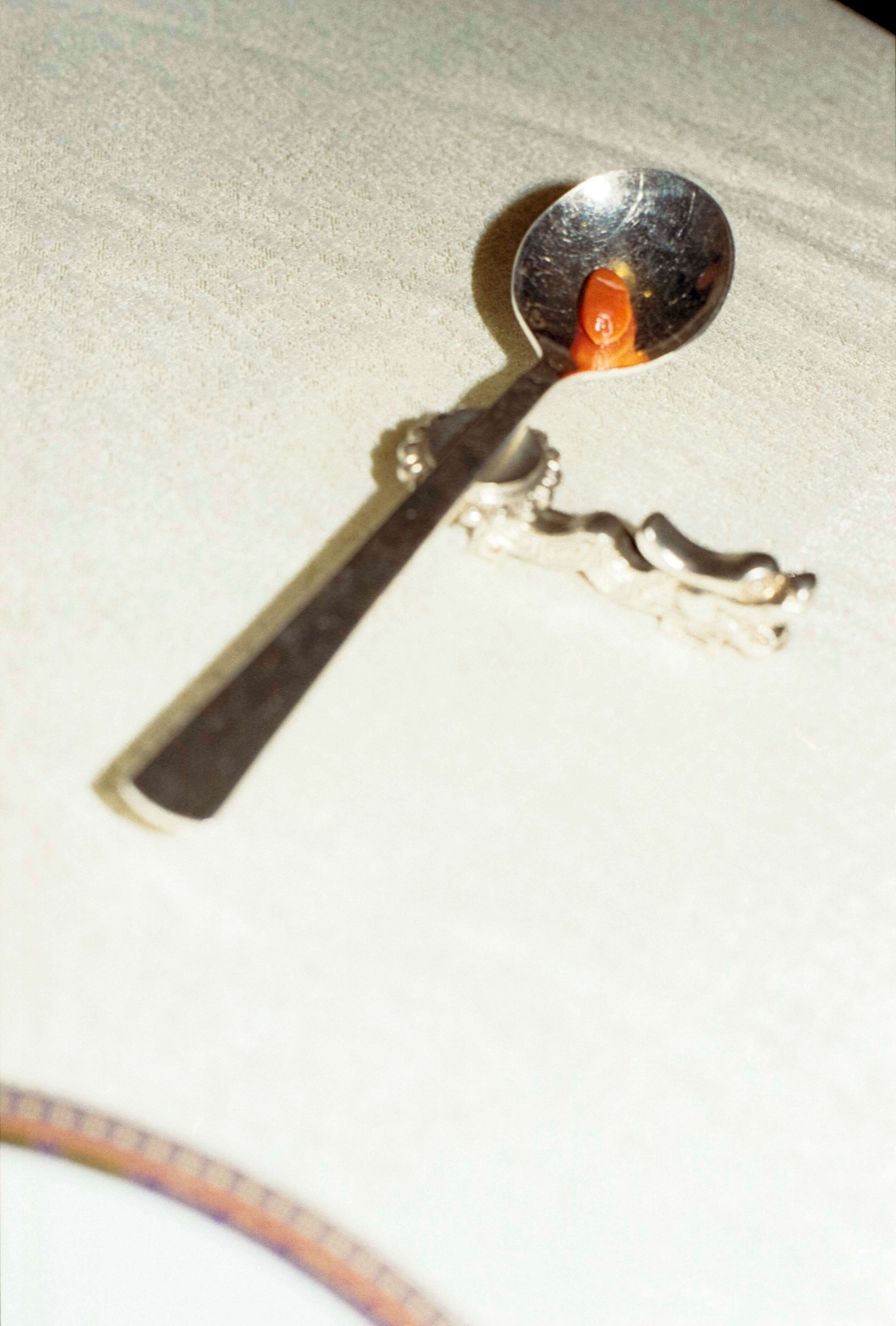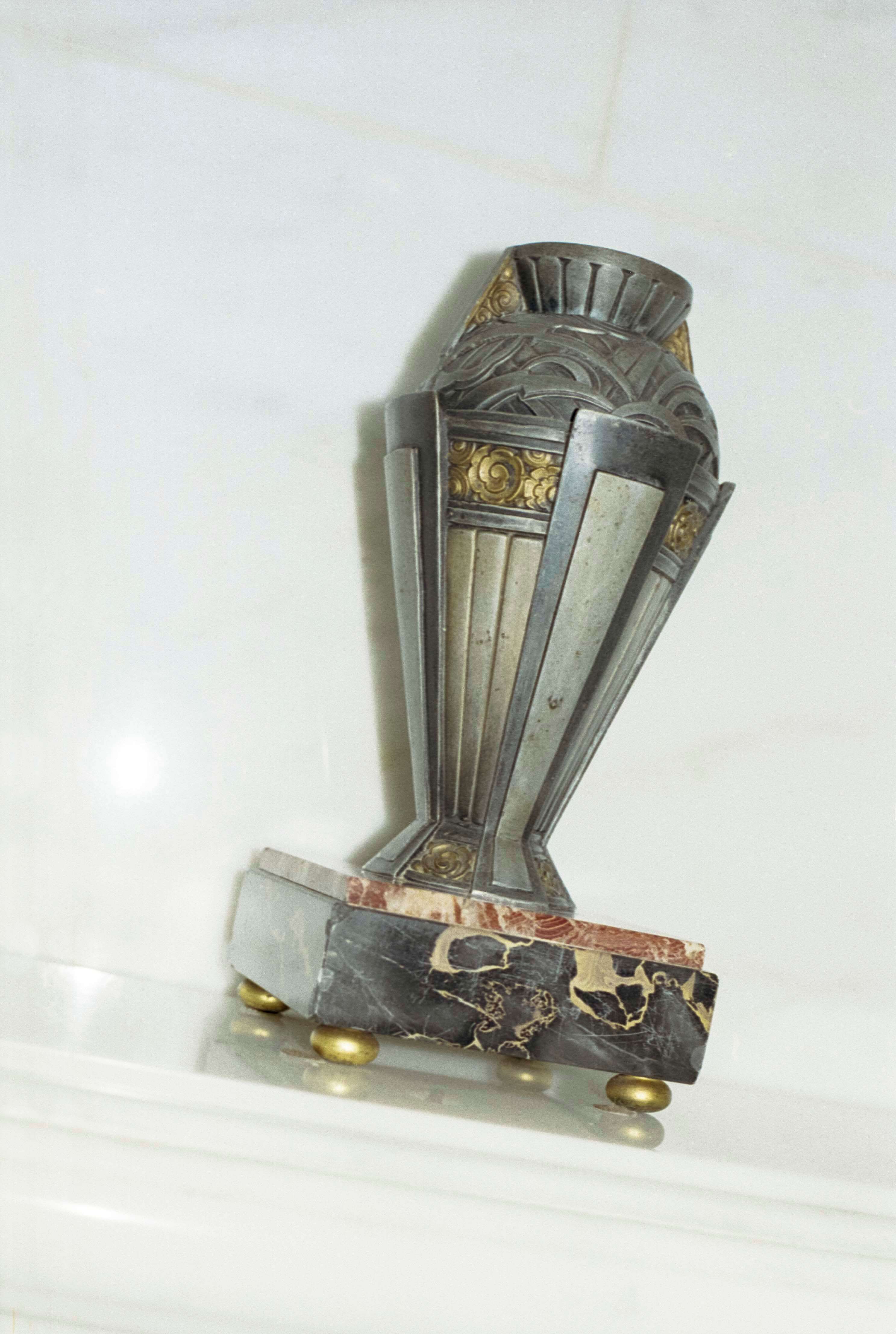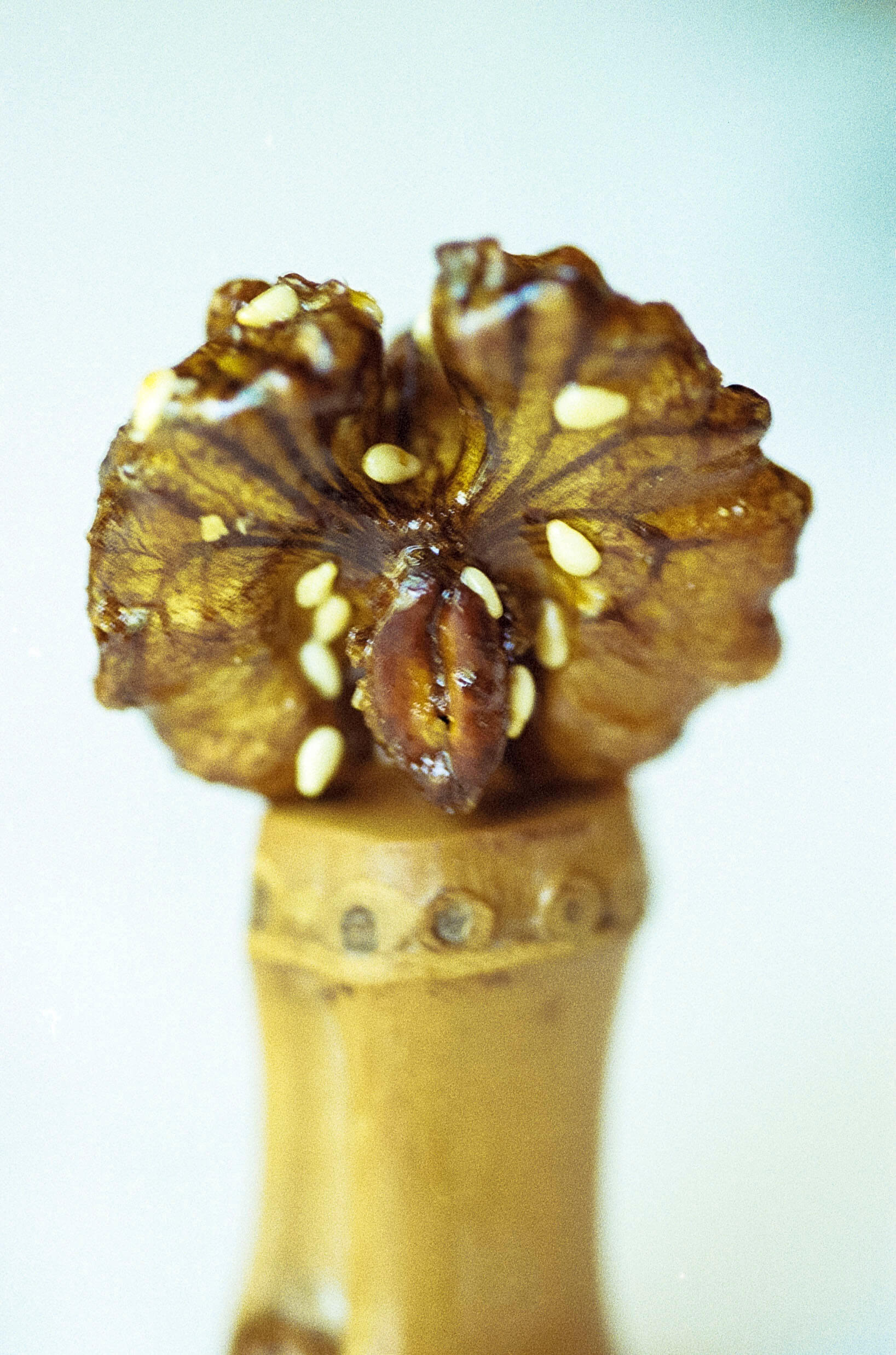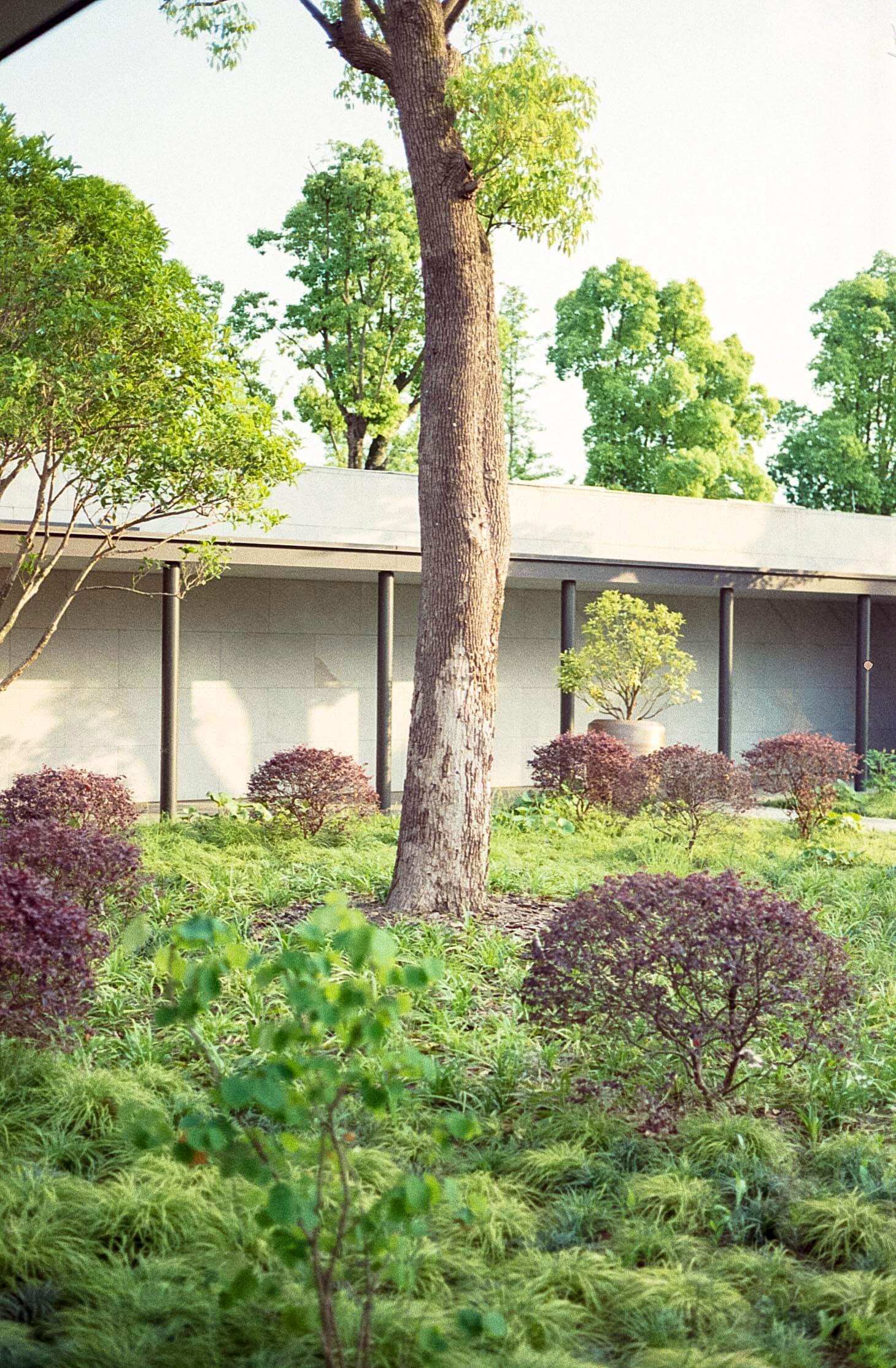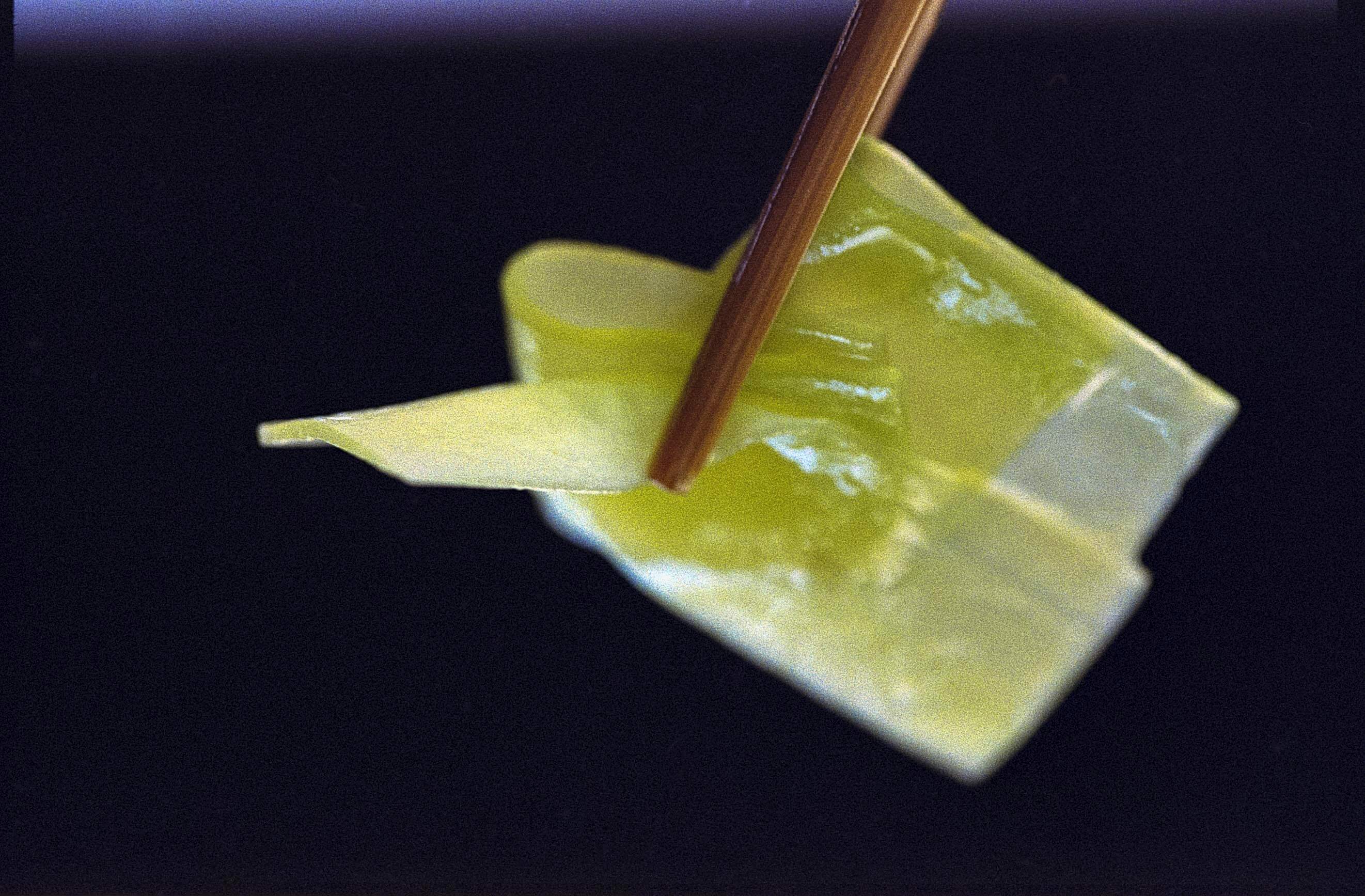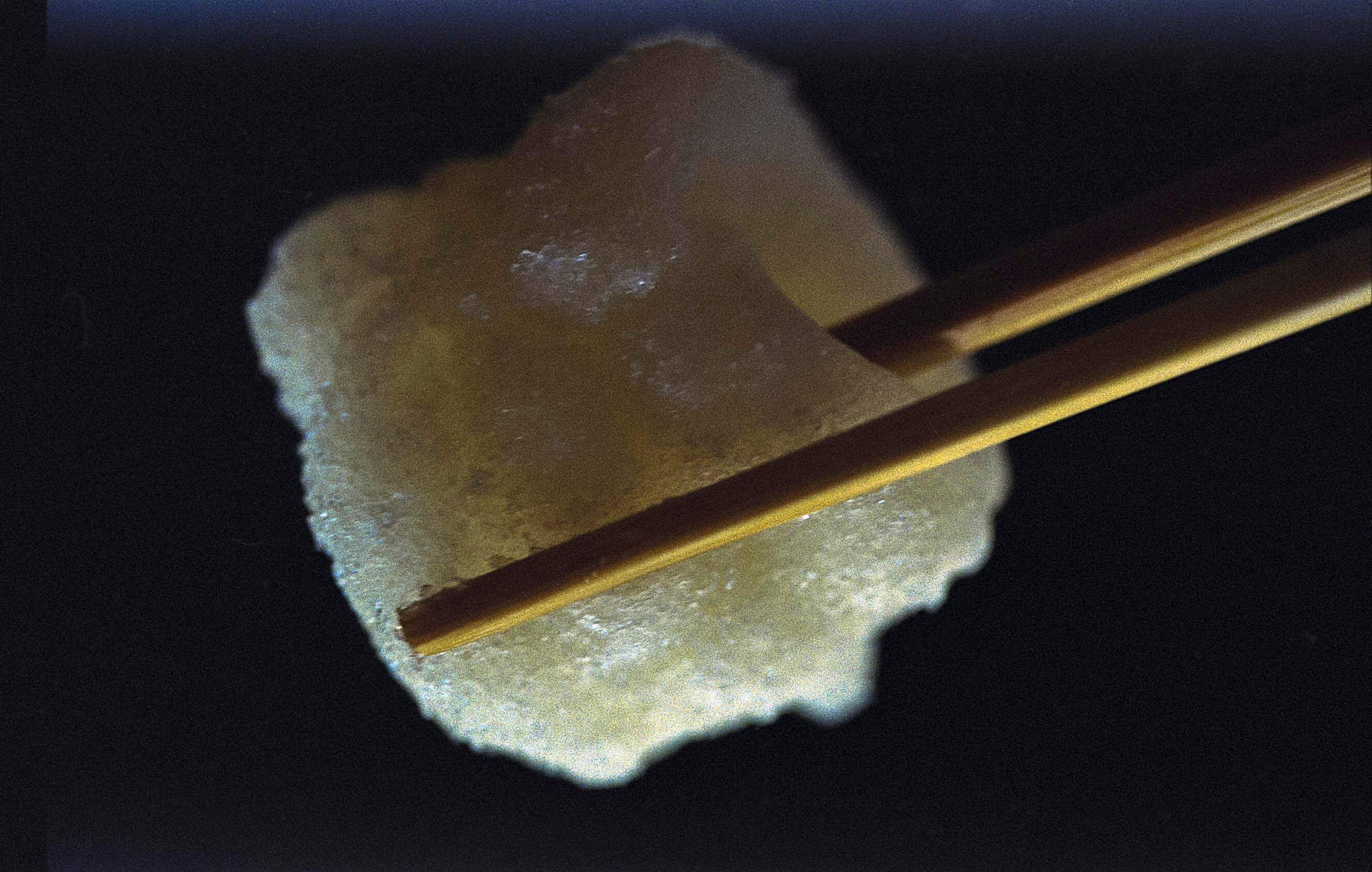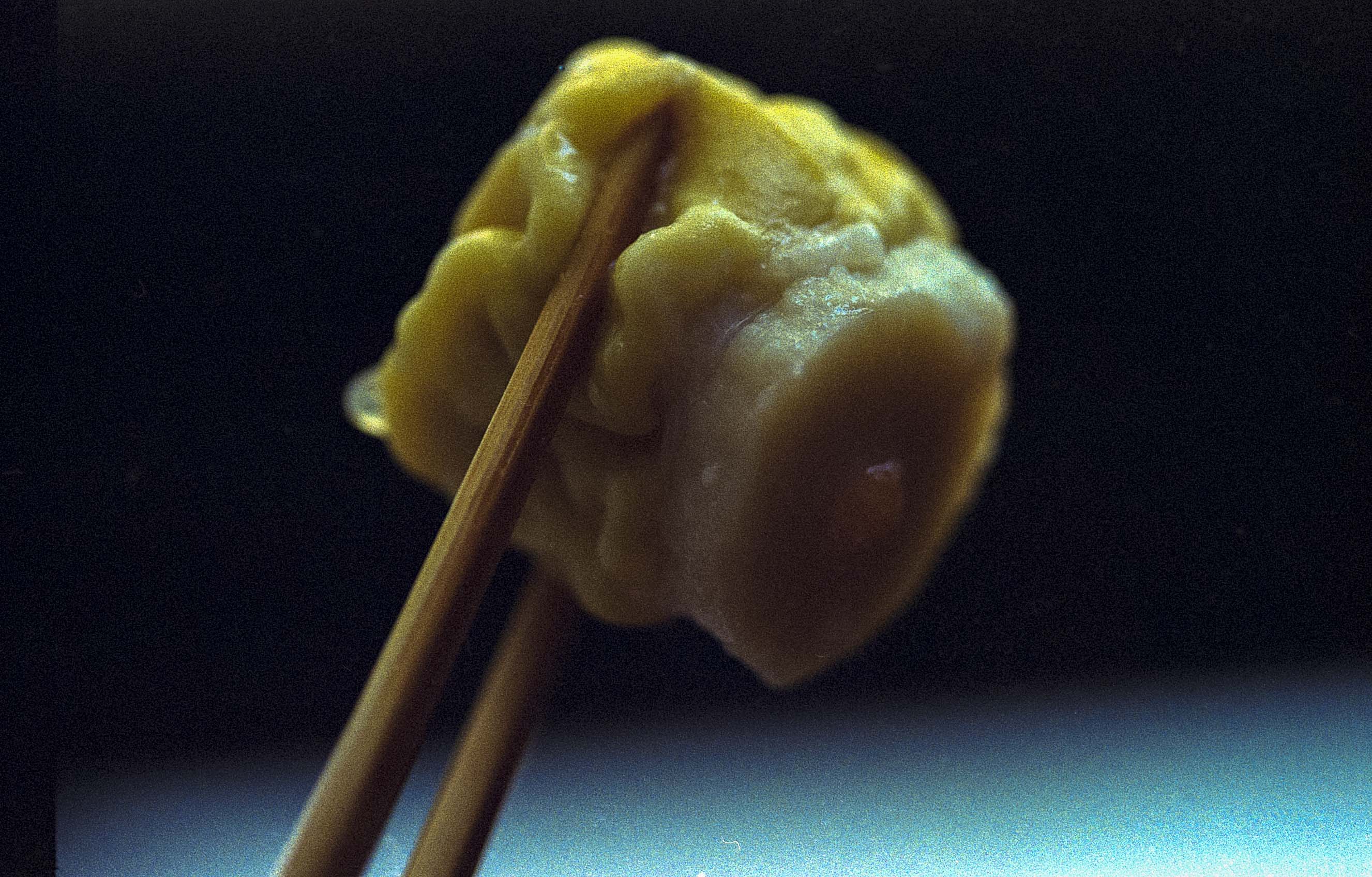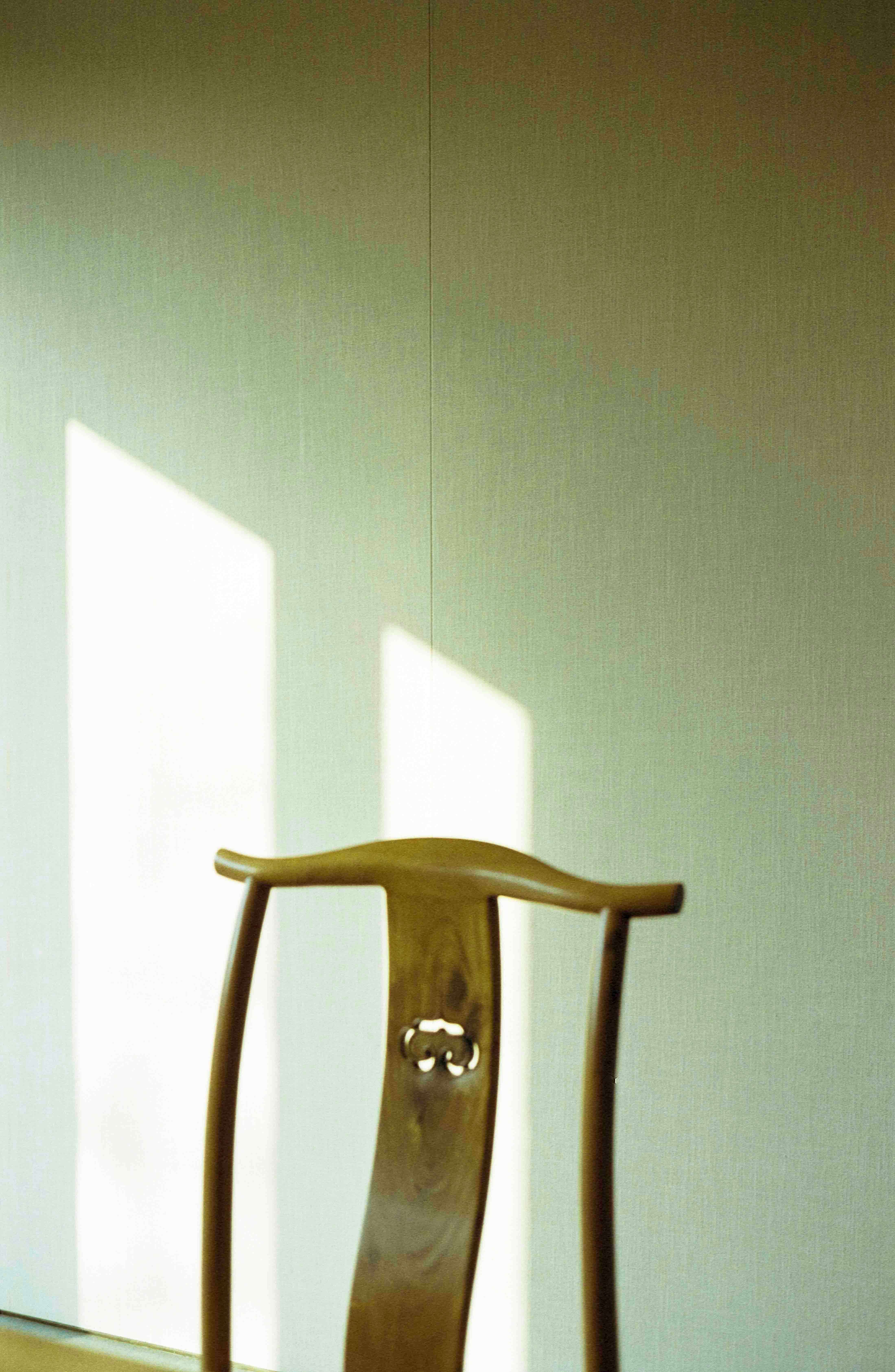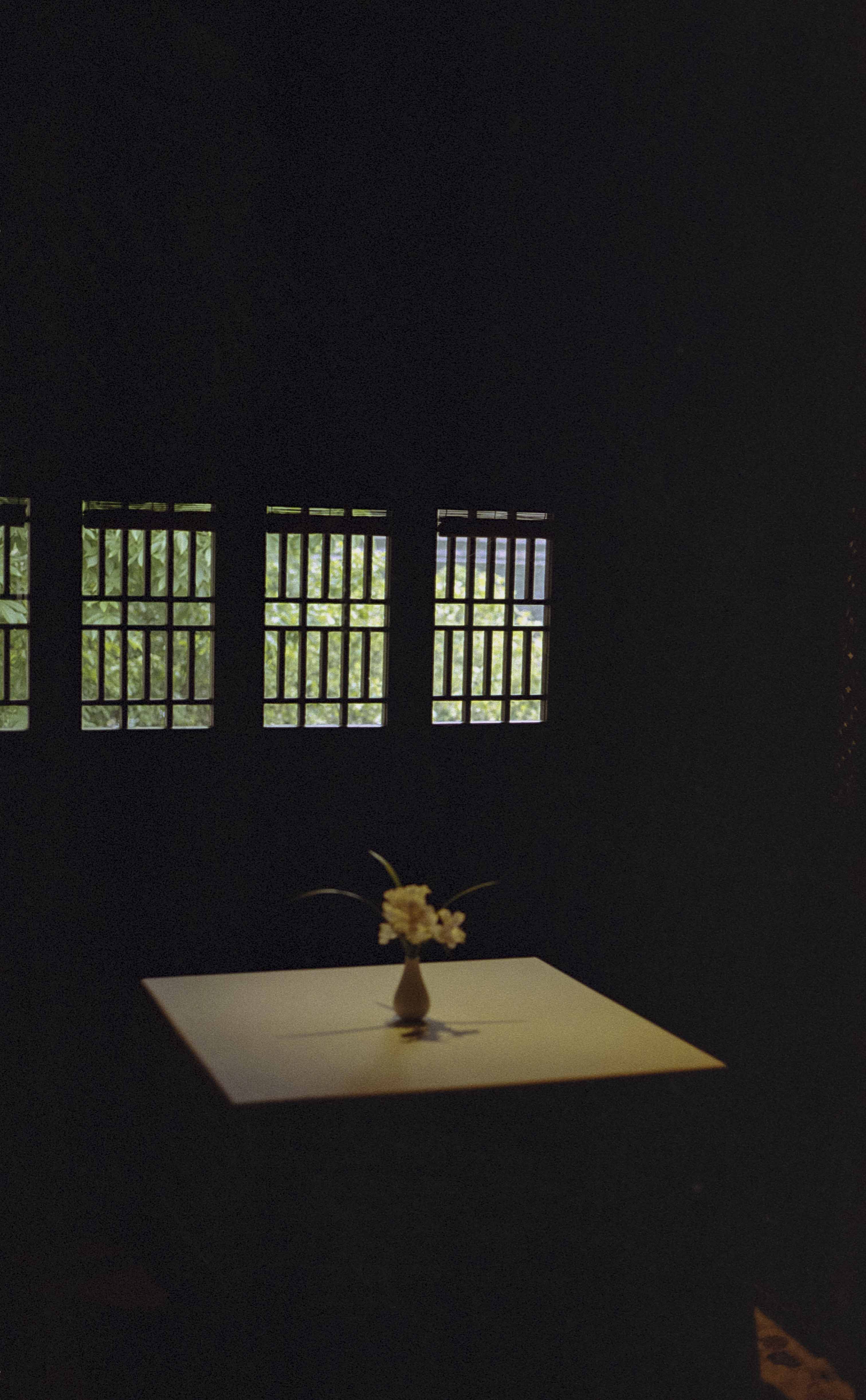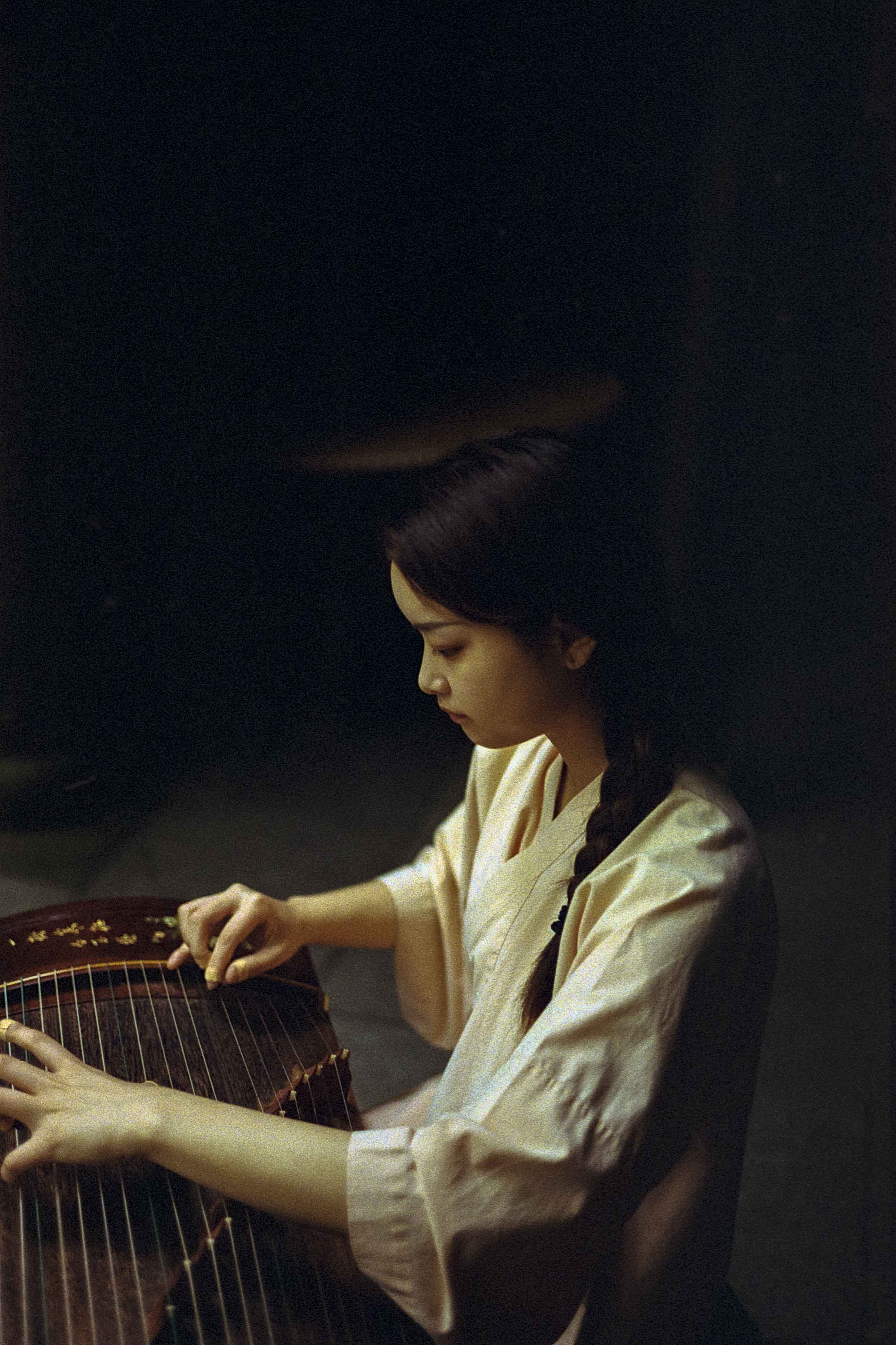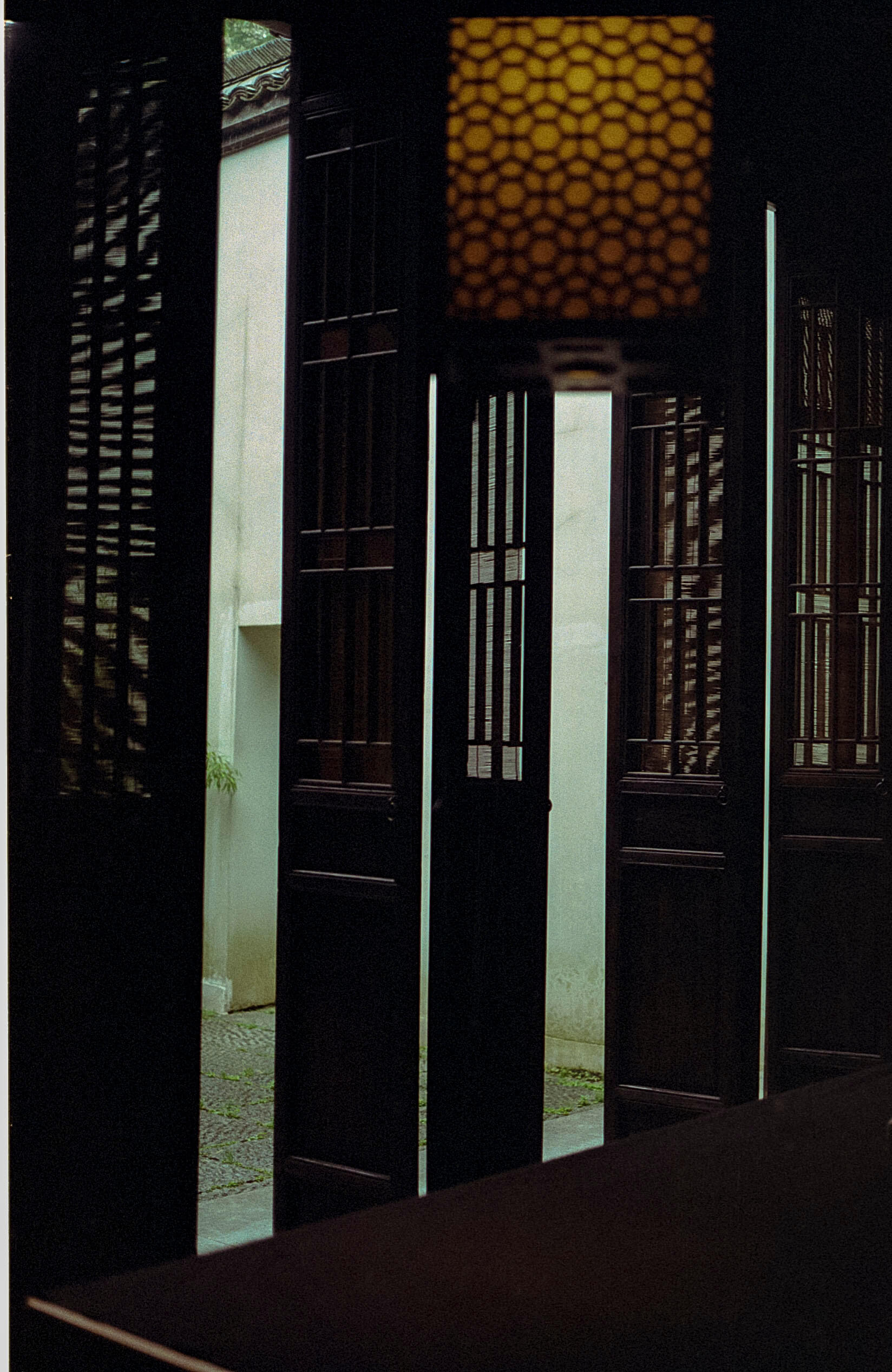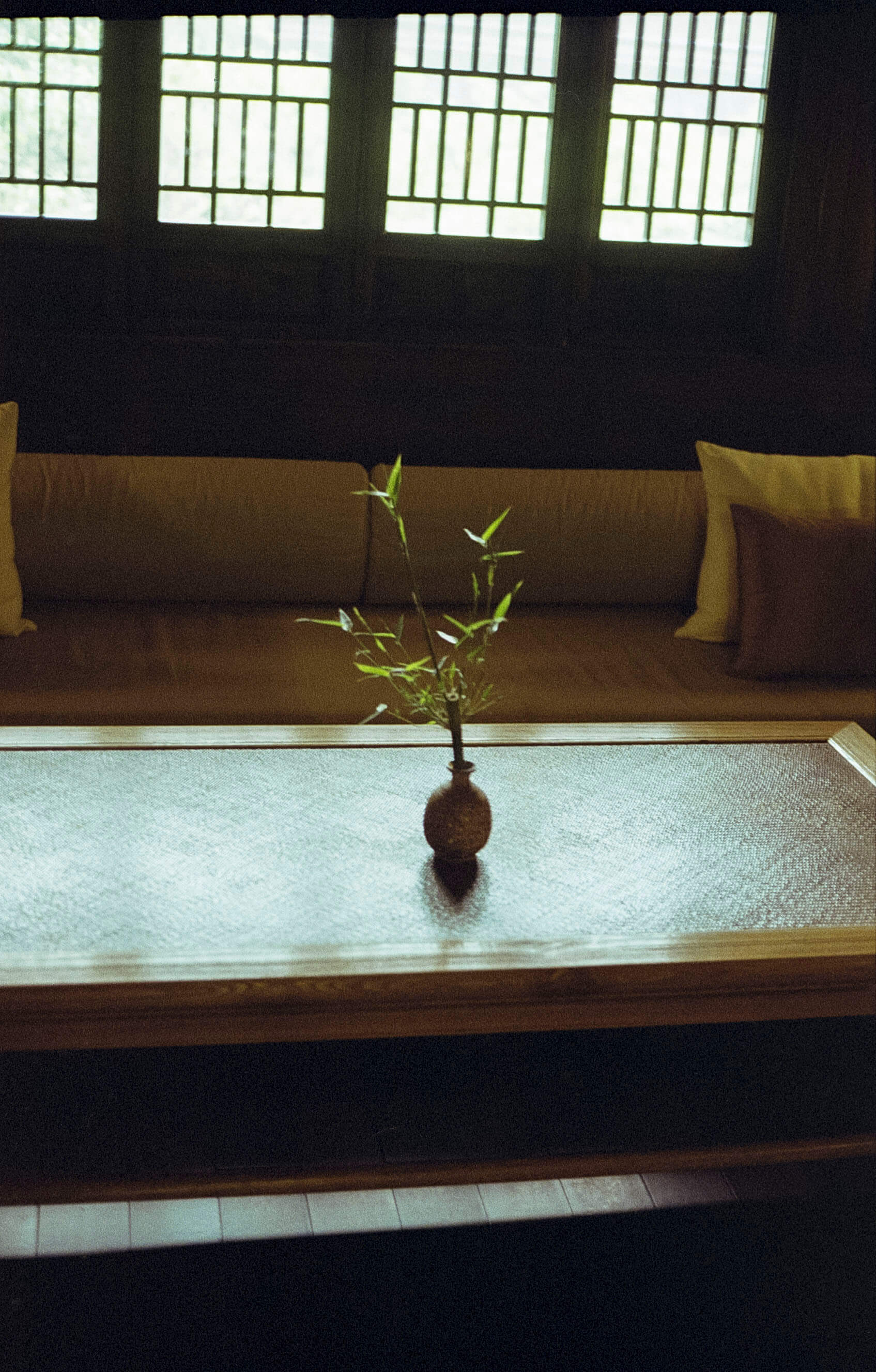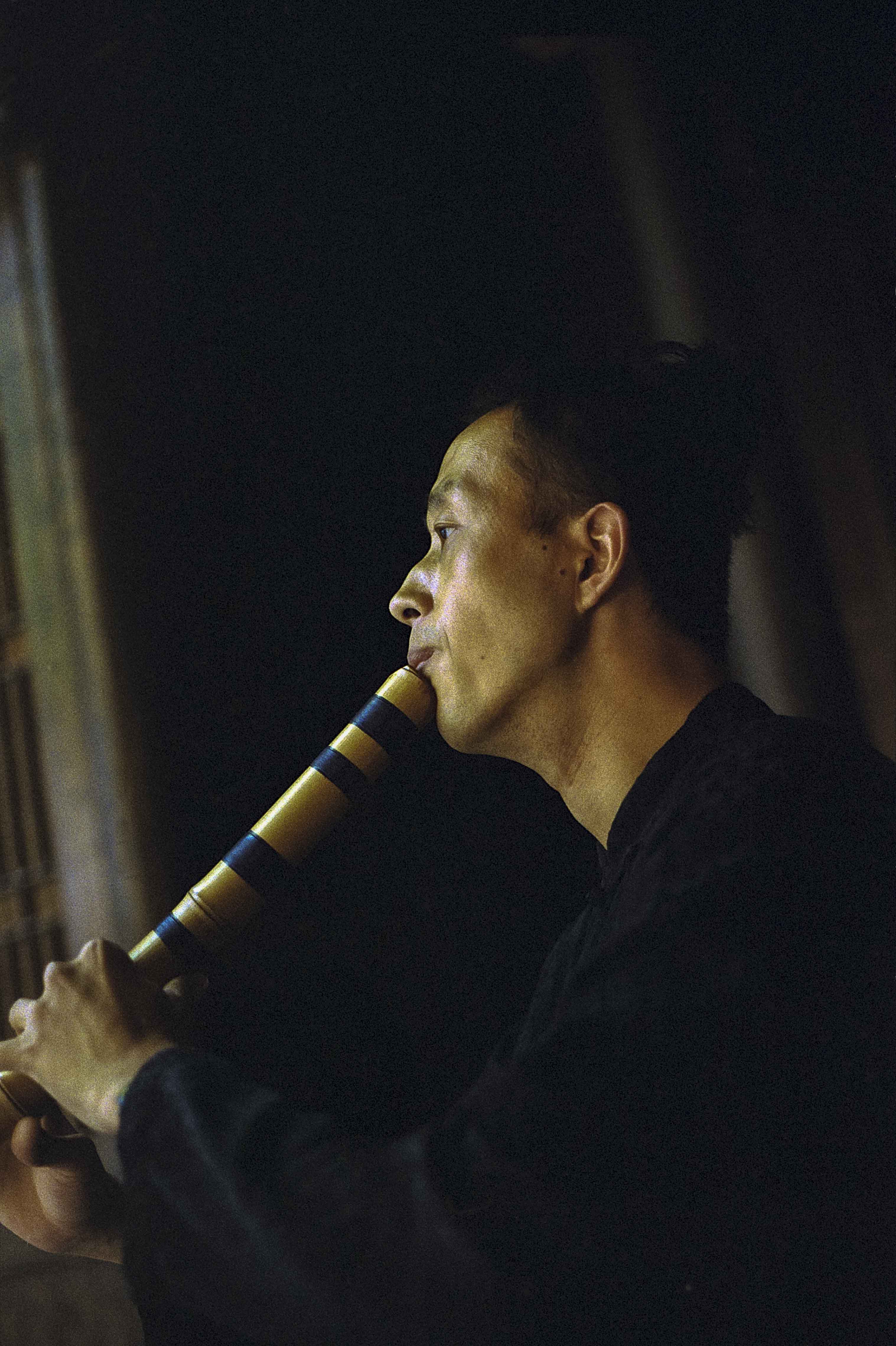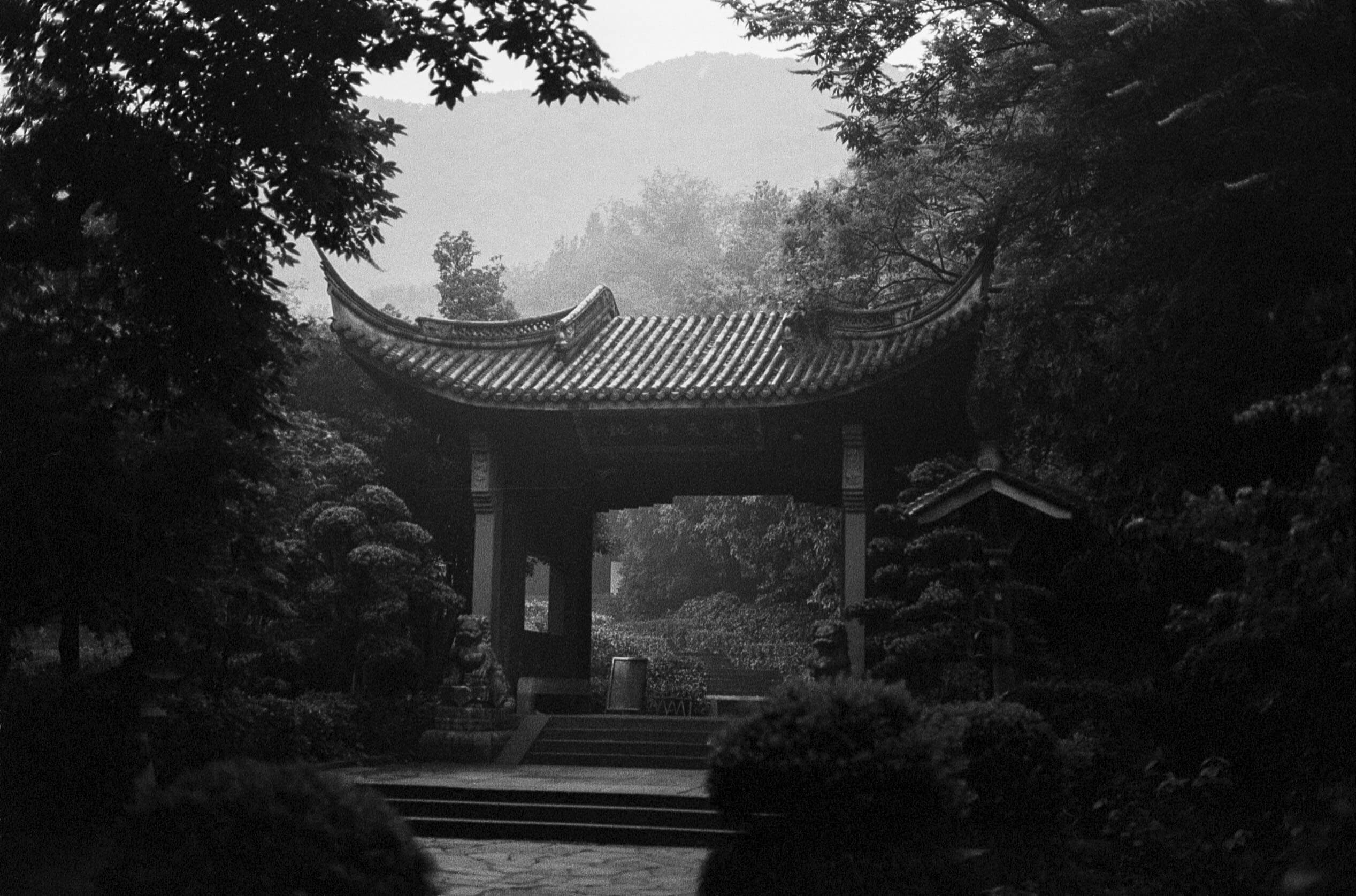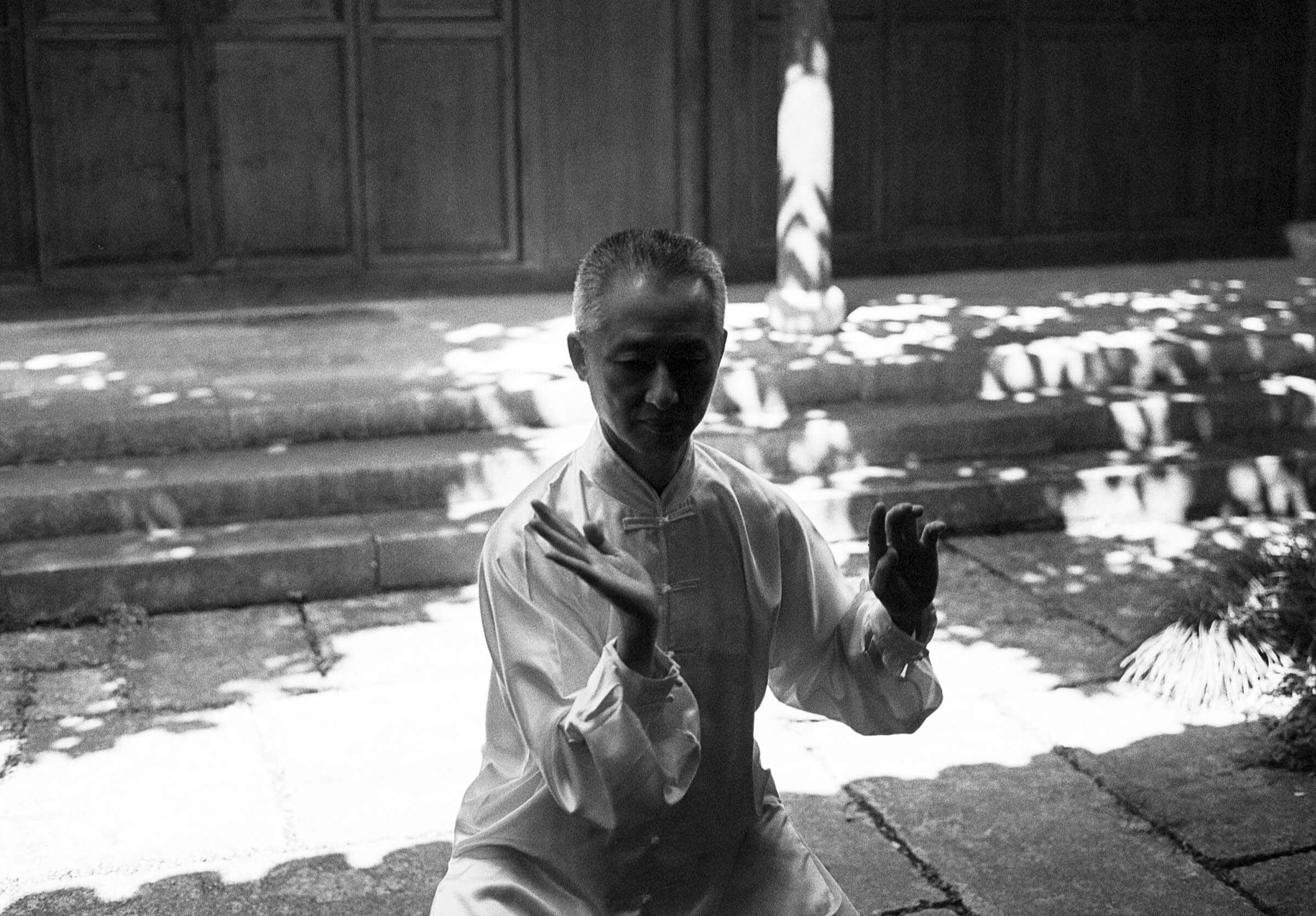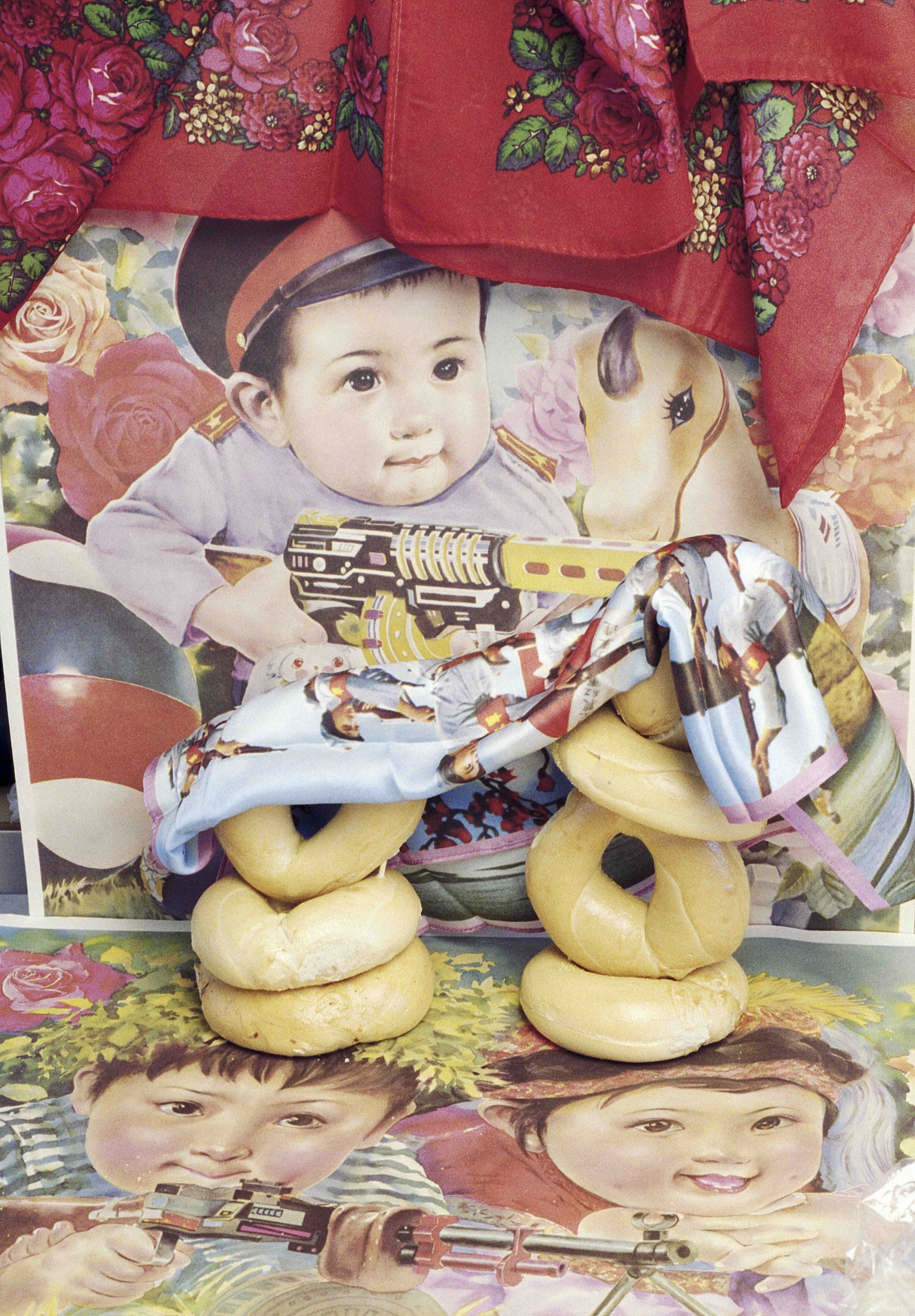
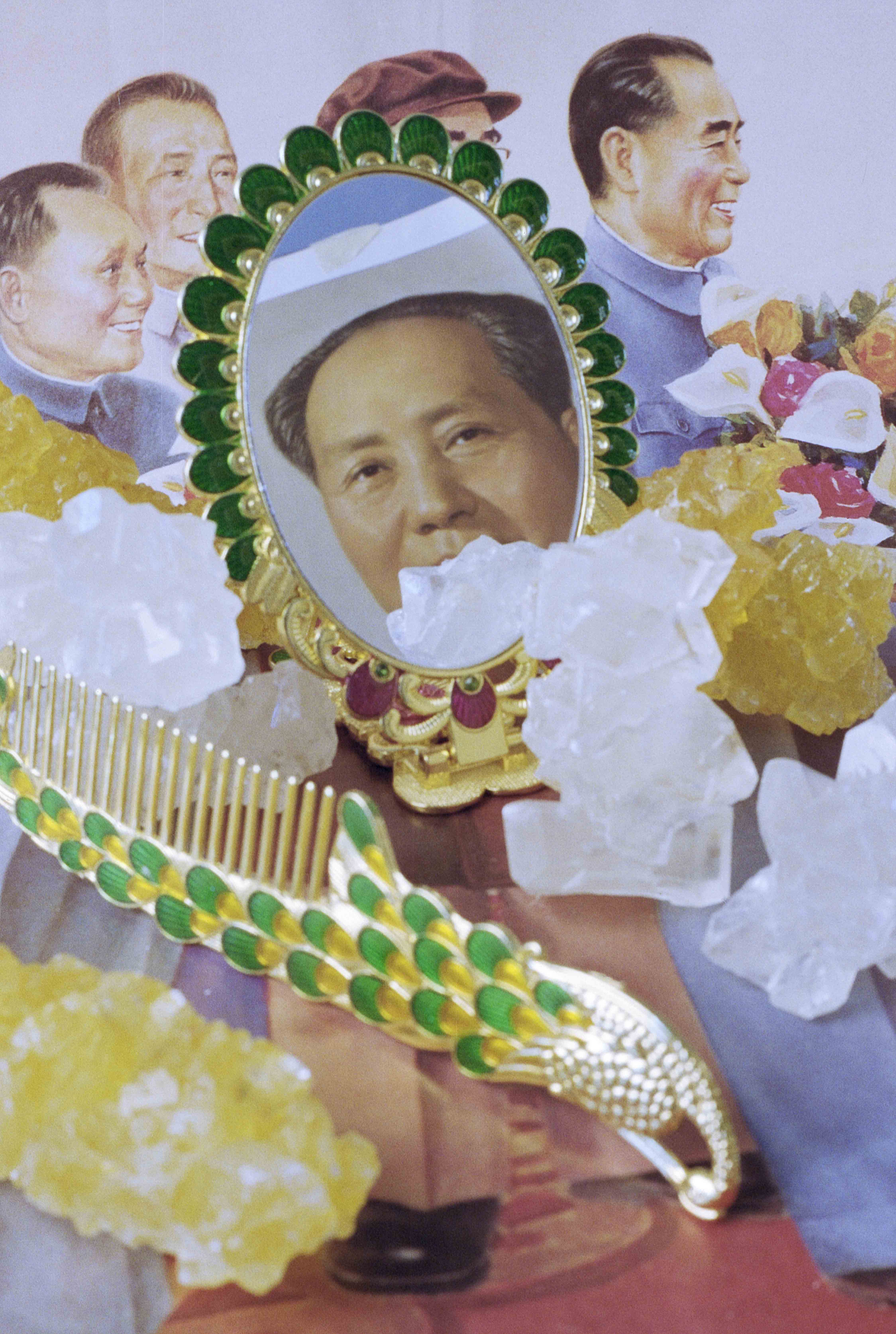

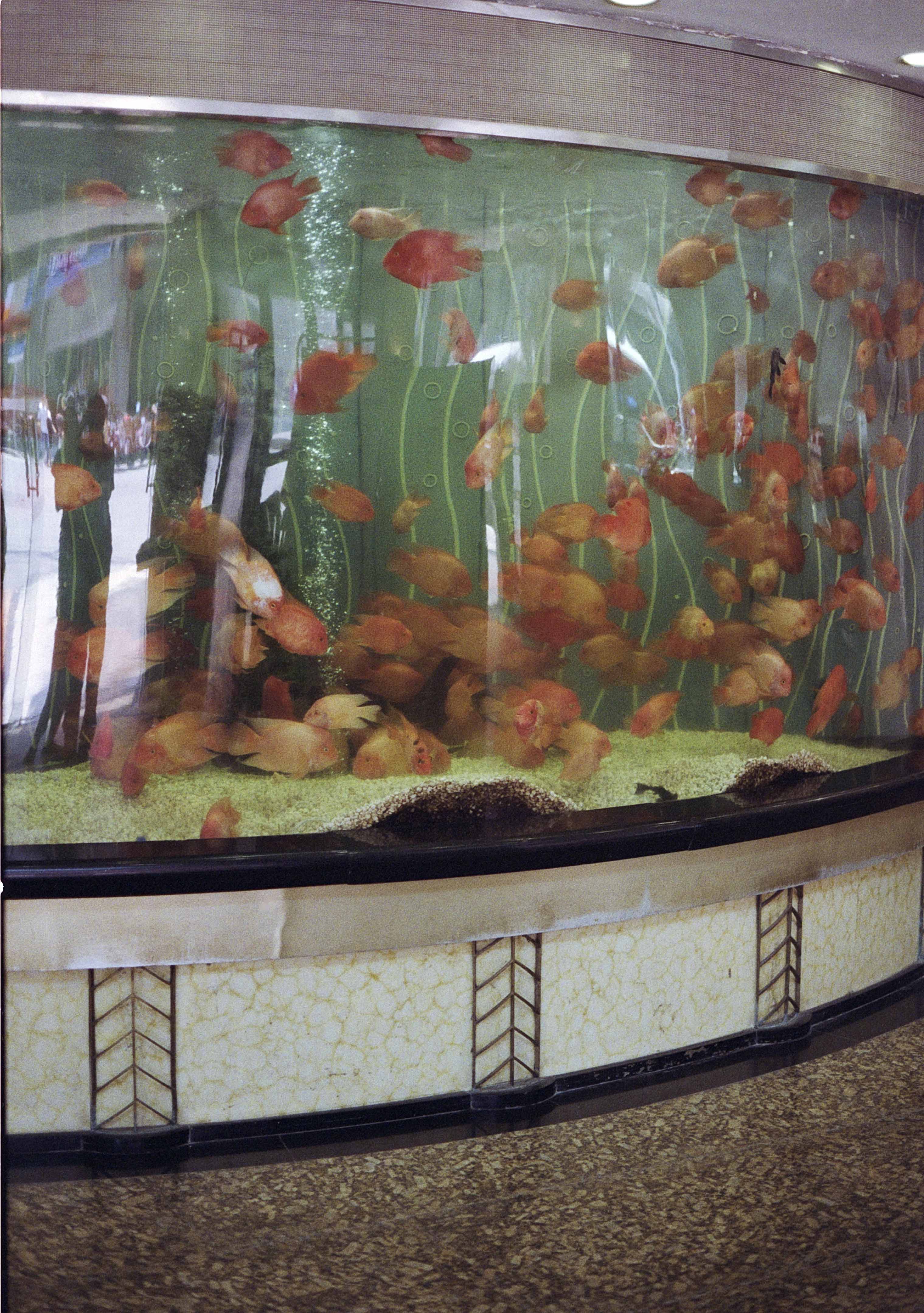
Red-rose print headscarves tied around necks, skin-toned sheer tights. Vintage posters of old Mao, vintage posters of young Mao. Banquets of lamb-beasts, sweat and aromas that smell of lamb. The aquiline nose and downy upper lip of the Tajik women. The monks’ silent mealtimes – the thumb and little finger touching the code to say we want a bit more, a slow circular movement of the hand with the palm facing upwards to say pour the soup onto the rice. Figs and mulberries in the courtyards of Kashgar, the children climbing a tall ladder in the square to eat the ripe fruits from the tree.
June snow in Tibet and the cold wind creeping up your thighs from the squat toilet. The “holy” fragrance of toasted barley flour burning in the mountain stoves. The light of yak butter candles, yak yoghurt, yak blanket, yak tent. Yak’s pee splashing into the milkmaid’s eyes and onto the Canon lens. The apprentice monks’ adolescent embarrassment. Are you on WeChat?
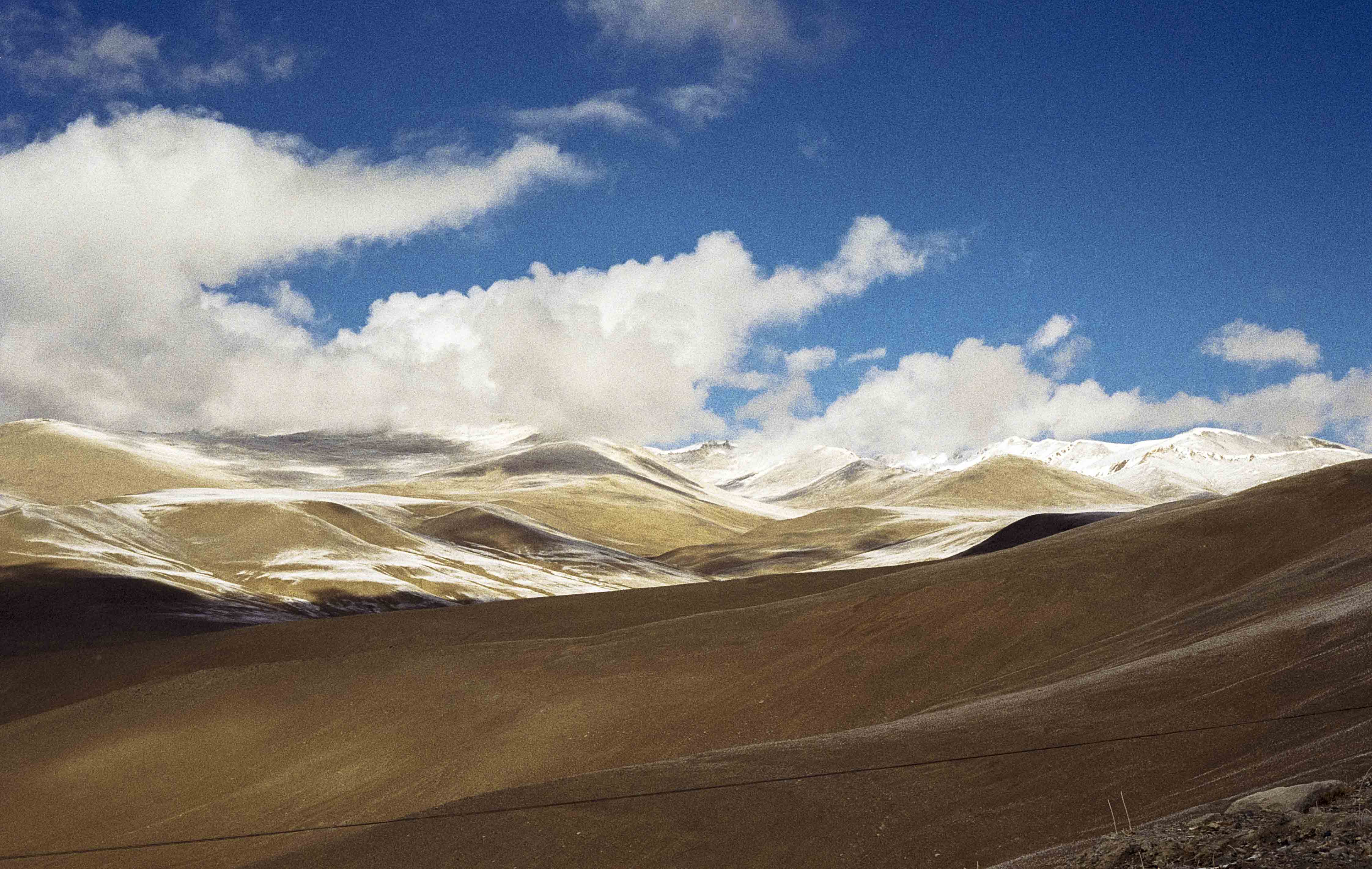
The Buddha of Wisdom’s sword cutting desire, anger and ignorance. The 108 wooden beads of the Buddhist rosary clasped in a hand. The sheep’s testicles squashed up against the bars of the lorry at the Sunday livestock market. The crowns of offal sausage at the night markets. Rehmat, “thank you” in Uyghur, the only word we’ve learnt, and Beijing banning the use and teaching of the Uyghur mother tongue in schools in favour of Mandarin Chinese.
The young receptionists of international hotels: horizontal eyes narrowed in apparent concern which in reality is pure physiognomy, under sharply pruned hedges of black hair, passable English. The soup bowls of hot water and black tea leaves set out on the table for everyone and the maniacal courtesy of keeping them constantly full. Boiled eggs in black tea at breakfast, all over China.

I realized that we had spent little time in the “Chinese nation”, among those of Chinese blood, meaning of the han race, 90% of a population of 1,4 billion people, which in actual fact includes over 50 ethnic groups.
Setting off from Shanghai and coming back to Shanghai, we found it hard to believe that we’d been in China all the time; in the end we understood that there are places “of China” that aren’t necessarily “Chinese”.
It was a mad but precise journey. We traced the lightning, intentional path of a ping pong ball touching an edge, called Shanghai, literally “on the sea” (Eastern Chinese), and bouncing back onto the other edge, the extreme west of “Middle Eastern” and Islamic Xinjiang, overlooked by difficult and promising frontiers.
The autonomous province of Xinjiang Uyghur, accounting for one fifth of the Chinese landmass, has been under the complete control of China since 1949. Bordering on eight states (India, Pakistan, Russia, Mongolia, Kazakhstan, Afghanistan, Tajikistan and Kyrgyzstan), it’s an obligatory route for trade with Eurasia. Everyone in Kashgar – 4,000 kilometres from Beijing, where the pets are camels and pigeons – feels more in Central Asia than in the People’s Republic.

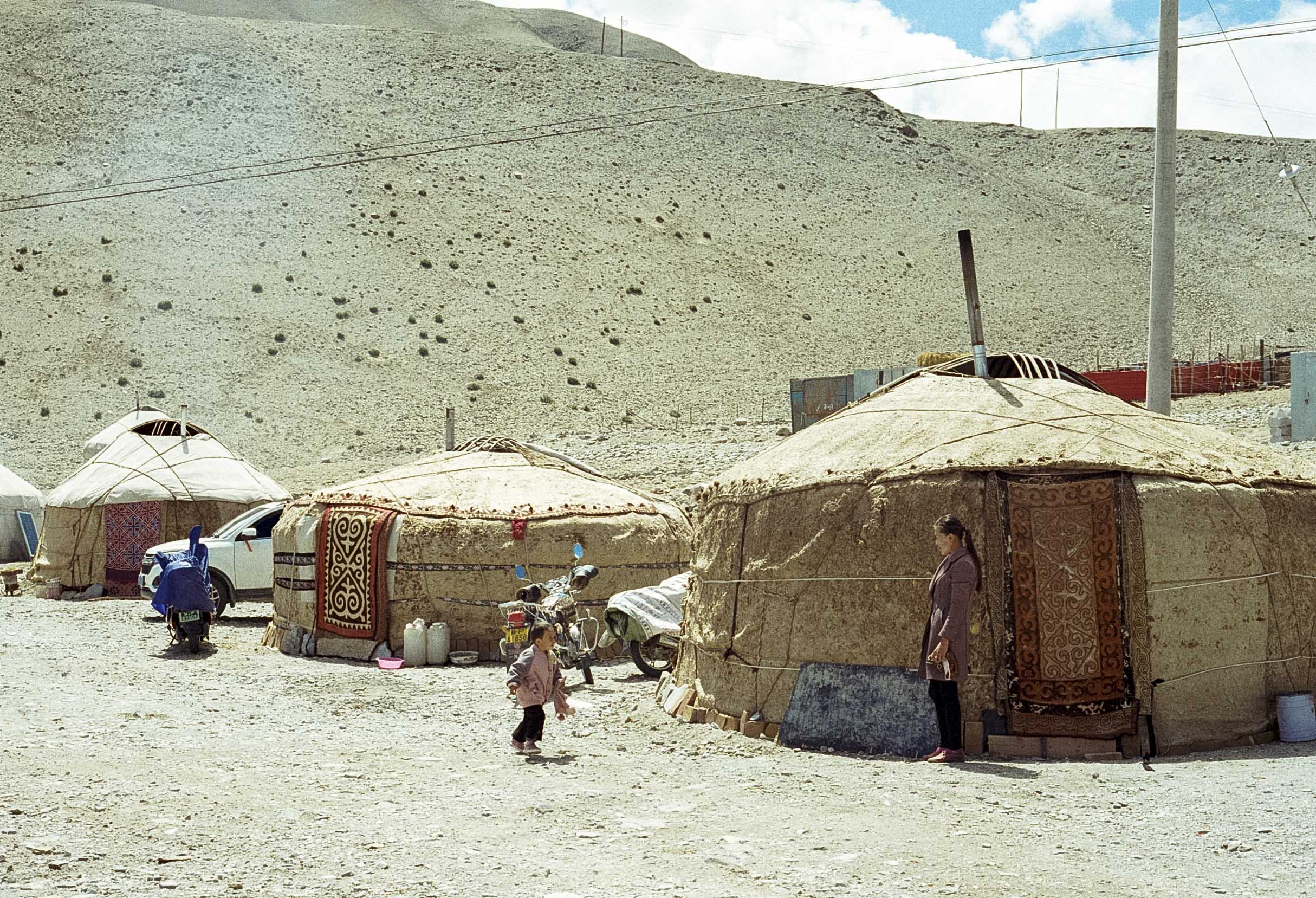
Halfway along its path, our ball bounced in the Tibetan monastic, nomadic, snowy prairies of southern Gansu. Once again, we chose to visit an autonomous region, Amdo, in a Chinese province: a cultural area laid claim to by the exiled government, over 90 percent of which is “occupied” by Tibetans.
Throughout our stay in China, the enormous presence of the han ethnic majority was upset into a ludicrous minority. In these provinces, Mandarin itself was a second language, almost a service language, as foreign as we were. And the exclamation so often heard by the Chinese in the biggest cities Ren tai duo (“too many people”) fell down here too: we crossed great deserts and mountains inhabited by peoples who accounted for less than one percent of the whole Chinese population and didn’t suffer from the urban crowds or pollution.
The Chinese dream proclaimed by Xi Jinping is that all those with Chinese descendancy, wherever they live in the world, feel directly involved in making the Chinas, plural, into “one great modern socialist country with Chinese characteristics”. But what about the Uyghurs, Kazaks, Tajiks and Tibetans “of China” who we’d made superficial and sweet friendships with those last few days?
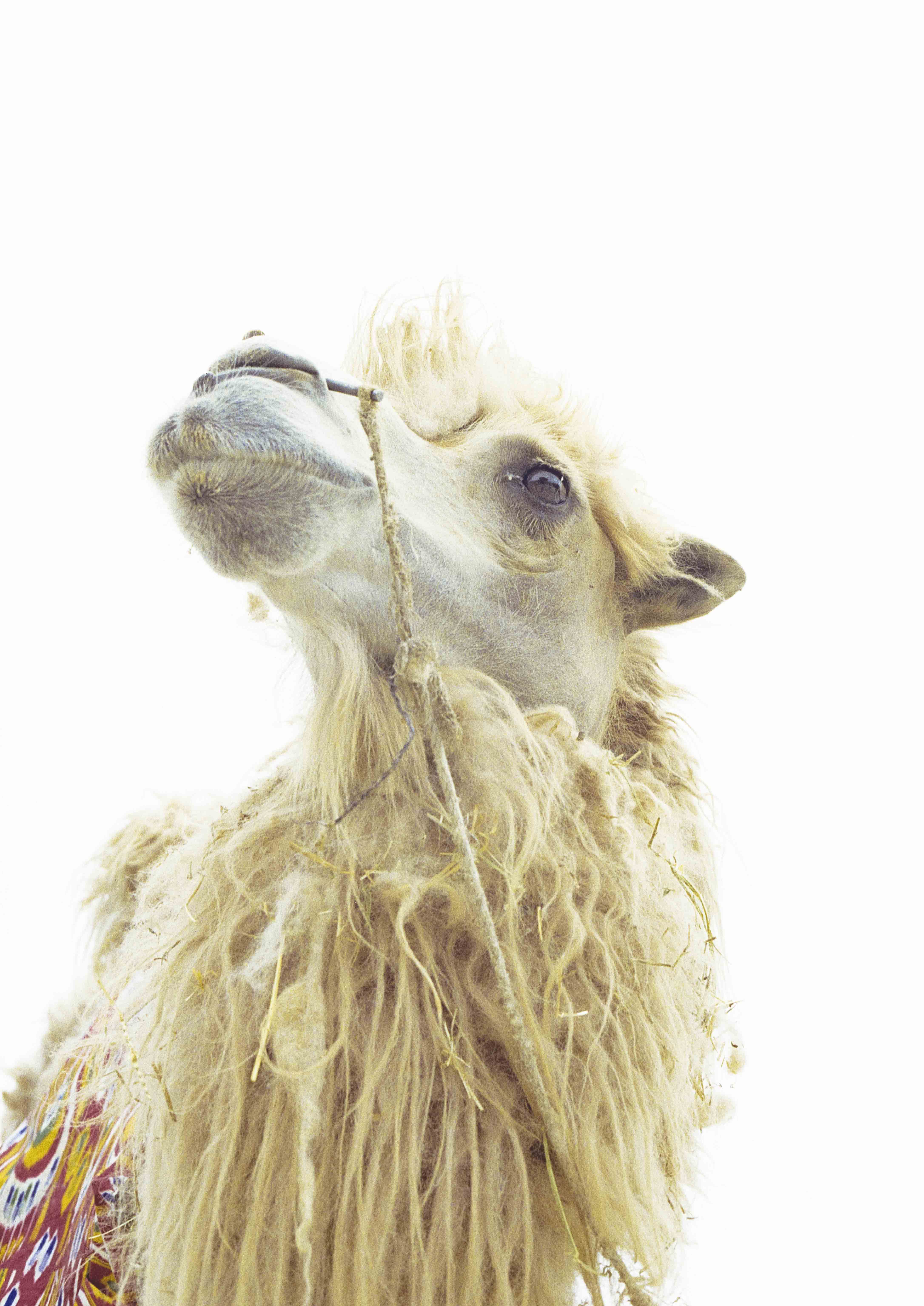
“As I think I said earlier, I don’t want to talk politics, I hope you can understand,” our guide whispers to me in my ear.
While it now seems clear in the West that a lunch or a dinner is more what you say than what you eat, at the table in Xinjiang they concentrate on the food, and smiles, and stifle the many questions that a European in 2019 would like to ask this population of “marginal” China.
Beijing time is a convention that the locals keep for the tourists, maybe just so there’s no confusion over the arrival and departure times of the domestic trains and aeroplanes. But the citizens of Kashgar wake up two hours before the capital Beijing, acknowledging and laying claim to the glaring cultural distance which is also actual geographical distance, a type of soft power creating an itch for the central government.
The xiao long bao full of piping hot Shanghai crabmeat will never have anything to do with the summer snacks in Kashgar, which smell of sweet melons, Mediterranean watermelons and Persian teas.
The 2008 Olympic show was based on total control, even of the sky. The Weather Modification Office released a series of rockets full of silver iodide into the sky above Beijing, causing short showers of rain which would sweep away the smog and return blue skies to the city. The Chinese one-time zone created to boost national unity made no sense even among a people used to a clearly authoritarian structure. We just pretended to follow Beijing time.
“He’s a noodle man,” our Uyghur guide, T.J., cheerfully justified the Chinese driver, our “minority” who didn’t speak Uyghur and had ordered noodles at lunch and noodles at dinner for the third day in a row. Perhaps it’s just what happens when the clock’s moved two hours backwards: even if he’d been born in Kashgar from parents born in Kashgar, a han would end up always ordering some variation of hand-pulled noodles, and when the summer comes, a refreshing bowl of cold jelly noodles from the fridge with grated courgettes, fresh coriander and spicy chilli paste.
In the People’s Republic, the legal age to get married is 20 for women and 22 for men. In the Kashgar desert landscapes, the woman’s family brings a dowry, the man’s pays the bride price in cash, and gifts are exchanged. T.J. tells us that the custom in the valley is for a young bachelor to get on a horse and gallop to the next village to choose the most beautiful girl to kidnap and make his bride. Once he came back to the village, the boy’s family would try to convince the girl to accept the marriage and so the caili would be paid and they’d celebrate with braziers of pulao rice dressed with peppers and carrots and yellow raisins in creamy lamb broth, samosas filled with beef and lamb fat, bowls of cold yoghurt and rivers of Kashgar rose black tea. The final adjustment to the story is that now it’s illegal to kidnap the girl if she doesn’t accept to get married. Bear this story in mind for later.
Jiayou, Zhonggou, Jiayou! (“Come on China!”)
Our international stopover in Shanghai, whose only real purpose was to get us inland quickly, had briefly brought us to brush up against the economically most developed eastern coast of China.
In 2011 the length of the high-speed road network in China overtook that of the United States. The Chinese project to expand its economic growth towards the western part of the nation was immediately clear to us when we drove on the motorway that runs parallel to the province of Xinjiang in the direction of Kazakhstan. The investments are still centred around access to energy, but that’s not all. We unwittingly followed a part of the Belt and Road Initiative, the President’s great geopolitical design for a network of physical and digital infrastructure, also known as the “New Silk Road”. The stretch in question goes through a 100% Islamic area, linking Kashgar to Islamabad through the Karakorum mountains, with the Turkish-Altaic-speaking Islamic Uyghurs on one side and, beyond the border, Islamic Pakistan.
Having driven through a brief snow storm and got past the third checkpoint, near to Tashkurgan, the last border city, delirious from the altitude we crossed a great gateway with a large digital panel bearing the words: “219 days to the end of poverty in China”. Xi Jinping had indicated 2020 as the year in which poverty would be eradicated, but our guide shook his head as if to say that it wouldn’t happen. It’s true that in China over 500 million people have exited a state of absolute poverty in the last 30 years, but the imbalances between different areas are clear for everyone to see, above all its citizens.
After our unlikely participation in a birthday party of local Jihadist Sunnis taking place in the big breakfast room at the international hotel in Tashkurgan where we were spending the night, we took the road from the day before in the other direction, over the highest pass on the sun-drenched and great golden groundhog-riddled Chinese Pamir Plateau. In China, as they told us just about everywhere, there’s only summer and winter, and it seemed to be true. Our countdown stopped at 218 days to the impossible end of poverty in China, when we progressively left Tashkurgan, the bewitching old city of Kashgar and the Xinjiang province for southern Gansu, heading by plane to Labrang (Chinese Xiahe) to be precise, in the Tibetan region of Amdo.
Labrang, 3,200 metres above sea level, continued to base its daily diet on nomadic rituals: yak yoghurt, tsampa (upland roasted barley) pancakes, rice with yak butter, and joma, a minute, protein-packed potato that can be picked just one month a year by scraping the ground under the red-brown prairie bushes. And for us Western tourists, rose root tea to cure altitude sickness.
In China a farmer, in Tibet a nomad only has the right to use the land he cultivates and limited chances of handing it on as he’d like. Yidam managed to guarantee his acres of grassland for ten years, because he’s the descendant of a nomad family who lived in Sangke before they were forced escape to India. If it hadn’t been for his wife Dechen, he might never have come back.
Ren tai duo (“too many people”)
At a certain point, between 2020 and 2030, the absolute population of China will reach its peak, and then it’ll start to drop. If I’d been born in China, my nieces and nephews wouldn’t have simply called me “aunt”, because a generic equivalent of this word doesn’t exist. In Chinese I was and would always have been a yímā, “mother’s sister”, and a mèi mei, “younger sister” of their mother.
I was especially attracted by the family structure of all the people of my age I met in China, all born in the cruel 30 years of the law on birth control. I was interested in the fragility of these families, blown out of all proportion by the immense probability of marrying someone in the same position. Individuals lacking the company of a brother or sister, nieces and nephews lacking the warmth of an aunt.
The one-child policy officially began in China on 25 September 1980, one month before I was born. The Chinese Communist Party asked, in an open letter to its members (who today, in 2019, count over 80,000), to voluntarily restrict themselves to having a single child. Hoping that it was a male heir, it’d be worth adding. As I was born in 1980, I’d have belonged to the first generation conditioned by this demographic system. A single and childless woman, I’d have occupied a very low rung on the Chinese social ladder.
I watched them tenderly, hoping they wouldn’t notice: two boys just over 20, clearly brothers, unlikely to be fathers in the West but here they were. Standing near together on the pavement in front of the primary school in Kashgar, every day at just before four in the afternoon, they wait for their children, pupils at the same school. Close to their still not very manly bodies, the brotherly love that no friendship could copy was clear to see. In another scene, at the Sunday livestock market two children aged perhaps nine observe the manoeuvre as the sheep are unloaded from the two-deck lorry: the first puts his arm around the other, he’s the one who starts the hug, and the other automatically clasps him back, interlocked for all that time, blood brothers.
To make the per capita GDP go up, the easiest way seemed to be to slow down the population increase, and so the Chinese made theirs an extreme model of economic rationalism. All over the world in the 1960s and 70s people were making love not war, but in China more than anything they were fearing a demographic collapse.
Today over 100 million only children are adults, in a generation that has only known immense economic growth and at the same time a solitude that having a sibling could have warded off.
Those who lived in rural areas were allowed to have a second child, so long as the first wasn’t a boy. And they were in areas with large ethnic minorities, like Xinjiang or Tibet where we travelled, too. Here seeing two or three brothers and sisters was as natural as it was prodigious. In 2013 Beijing announced that it was allowing all dandu couples (families in which at least one of the two spouses is an only child) to have a second child. For the nation, it was the turnaround needed to give its growth a new boost; for a human being, a brother or a sister would give them the most lasting family relationship they’d experience in their lives.
We walked through the Saturday marriage market at the People’s Park in Shanghai where now-retired parents display handwritten adverts for their single sons on umbrellas. We could only understand the Arabic numbers in what seemed to be recurring information: age and height in cm, plus a series of characteristics on the education and temperament of their “little emperors”. They were parents of only children worried about the future of their paltry Chinese family: after the romanticism and adventure of paternity, only with descendants will we have someone we can count on in our old age. According to an old proverb: “China will grow old before it grows rich”.
Nature is the way
Things we’ll remember about China.
The whole day of an elderly Uyghur could be spent in a tearoom dipping hunks of big round nan bread cooked in tandoori ovens in cups of fragrant tea – a few strands of pure saffron from Iran, plenty of green cardamom, a handful of goji berries and rose berries from Kashgar. In the guest room of every traditional Uyghur house is a perennially laid table topped off by a swirling sculpture of fried bread rings which can remain fresh for up to a month, together with nuts and dried fruit from the Grape Valley in the low-lying area of Turpan.
Until a generation ago, the whole day of a nomad child from the Labrang prairies was spent with the animals, on average 100 unfenced yaks and 300 sheep. Today the families get together in cooperatives to extend their private properties to a piece of good pasture and transform the nomad rites into an economy: milking twice a day, producing yoghurt, butter and hard cheese, alpine tourism, after the religious tourism of the monastery school of the Yellow Hats guided by the Dalai Lama.
The day of a modern teenage monk could be summed up in three words: Buddha, basketball and beer. And let’s add WeChat, the Chinese WhatsApp. We can only guess – because we’re not allowed in – that the philosophy and sculpture lessons are the same as in a prestigious American college. During the holidays and the brief summers, the monks are free to go out and they climb up to the alpine pastures, where, as well as picnicking, if they’re in the medicine department, they’ll go to forage wild therapeutic herbs.
In Zorge Ritoma, in the autonomous Tibetan prefecture of Gannan, an American coach is training a professional team of basketball players, nomad boys watching nomad boys in the NBA on television. You can see them straight away queueing at the canteen of the yak khullu wool factory-atelier where practically the whole village is employed, except for the residents of the Labrang monastery outpost. Every so often the Chinese police slowly pass by in their patrol car on the dirt roads.
In 2015 in Shanghai a caili already cost around 16,000 dollars and marriage was also an economic matter. In 2030 one Chinese man out of four will be a bachelor and won’t be able to find a partner. In the country and city alike, there simply won’t be enough young women of marrying age.
May is the start of the apricot season in Kashgar. Everyone buys cardboard crates of them at the airport; some go back into the city with plastic tubs of fresh yak yoghurt. The local specialities migrate with the people and nostalgically link the different Chinas that we met.
In the Maoist propaganda posters, chubby children with red cheeks hold guns and play happily at war, surrounded by peaches and peonies, two symbols of plenty. Who are they shooting? Who are they trying to pick off?
Amanyangyun Shanghai
Its name is “Yang Yun”, part of a 300-year-old inscription within Beijing’s Forbidden City meaning “nourishing cloud”. Meticulously designed by Kerry Hills Architects, the mantra was for minimal interference with the original history and heritage of the traditional Ming and Qing Dynasty courtyards. For instance, each courtyard preserves the second hidden inner courtyard, the open sky above, a nurturing cloud inside the family house. For 16 years, brick by brick, the young owner moved his hometown from the legendary region of Fuzhou in Jiangxi Province, with the spectacular addition of a flourishing forest of around 10,000 ancient camphor trees. In China, there’s an indissoluble link between a house and its trees. A house can’t even be imagined without its trees, so they all get moved together. At the beginning it was merely a project of “salvation”: to save childhood memories, to save symbols of power and knowledge (the village was home to families of seventeenth-century literati), to save the Chinese craft of carving seals in precious nanmu wood, to save China from brutal modernization and a frenetic future.
Amanfayun Hangzhou
According to the history books, Lingyin Temple received a royal visit from Emperor Kangxi of the Qing dynasty on his tour to Hangzhou in the twenty-eighth year of his reign (1689 AD). The abbot at that time, Dihui, begged the emperor to write a plaque for the temple. Upon this request, the emperor wrote literally “cloud forest”, giving the temple its new name. Amanfayun is where you can find the Buddha, amidst a mysterious misty forest as the night turns into day. The wheel of transmigration never stops turning, just like the chants of the monks and the beat of their drums at sunrise in Fayun Village. Lóng Yī Master, our tour leader at the Hangzhou Buddhist Academy, says that “the village” is “the land” and Fayun the last place Buddha is due to come to before his enlightenment. The camp is designed in a wan shape, called “ONE”. Lóng Yī believes in “cause and effect”. He also believes in samsara and the six realms, that is, Heaven, Human, Asura, Animal, Hungry Ghost and Hell. He believes that all creatures are equal.
Buddhism first reached China from India during the Han Dynasty roughly 2,000 years ago. It was probably introduced to China by Silk Road traders from the West. Gradually its influence was felt in the heart and blood of Chinese culture. Today, China’s population, the largest in the world, counts 1.4 billion, and Buddhism is the religion of the majority.
Happy Talking. The most Chinese of our encounters was with the teacher of Tai Chi, Lei Ming, a delicate and flowingly graceful man, in a traditional white silk suit and cotton lace-up shoes. He’d just finished writing a long book on his experimental research: the application of Tai Chi to modern life, through the practice of happy talking. “Everyone can do Tai Chi, but Tai Chi is not for everyone”, he said. “It depends what you want to be, what type of person you want to be. Human beings are funny animals, because when it comes down to it, that’s what we are, animals. And in nature everyone acts according to its nature, the snake, tiger, tortoise, no animal would dream of copying another animal. But we humans are odd, we see something we’d like to be, and we try to copy it. We might even end up resembling it, but in the end we’re not ourselves, we’re moving away from our nature.”
